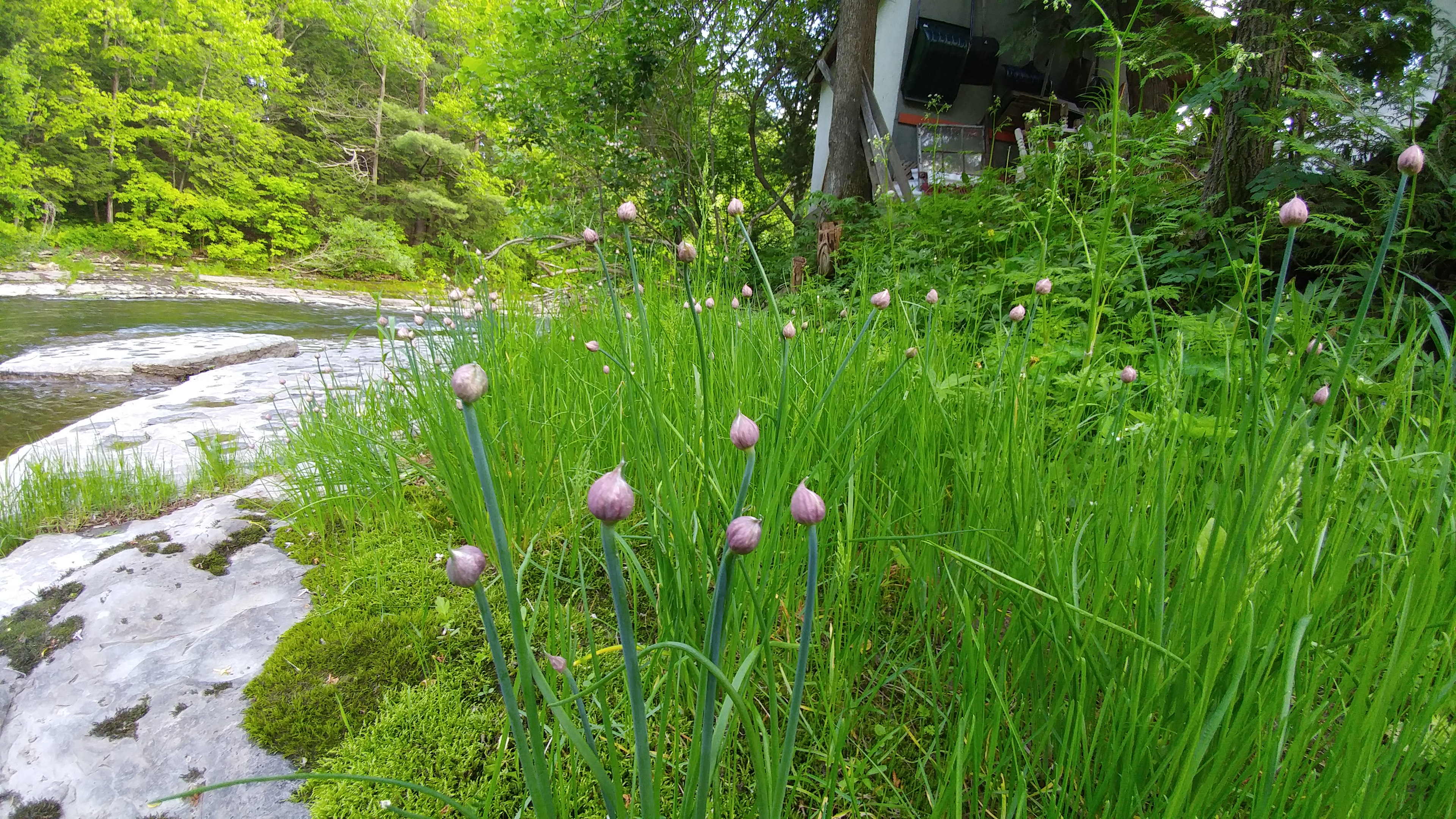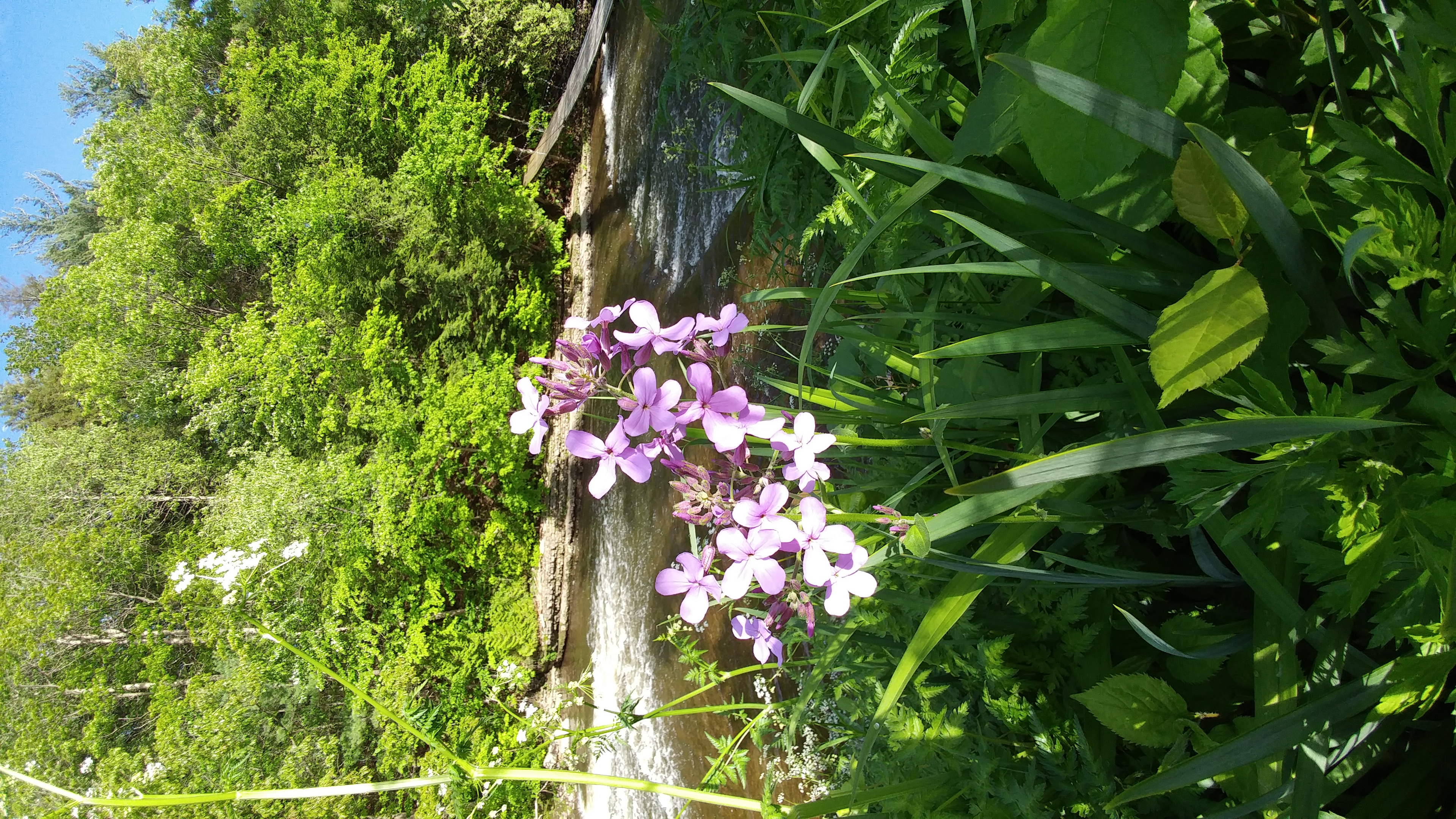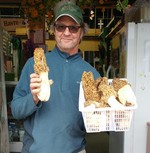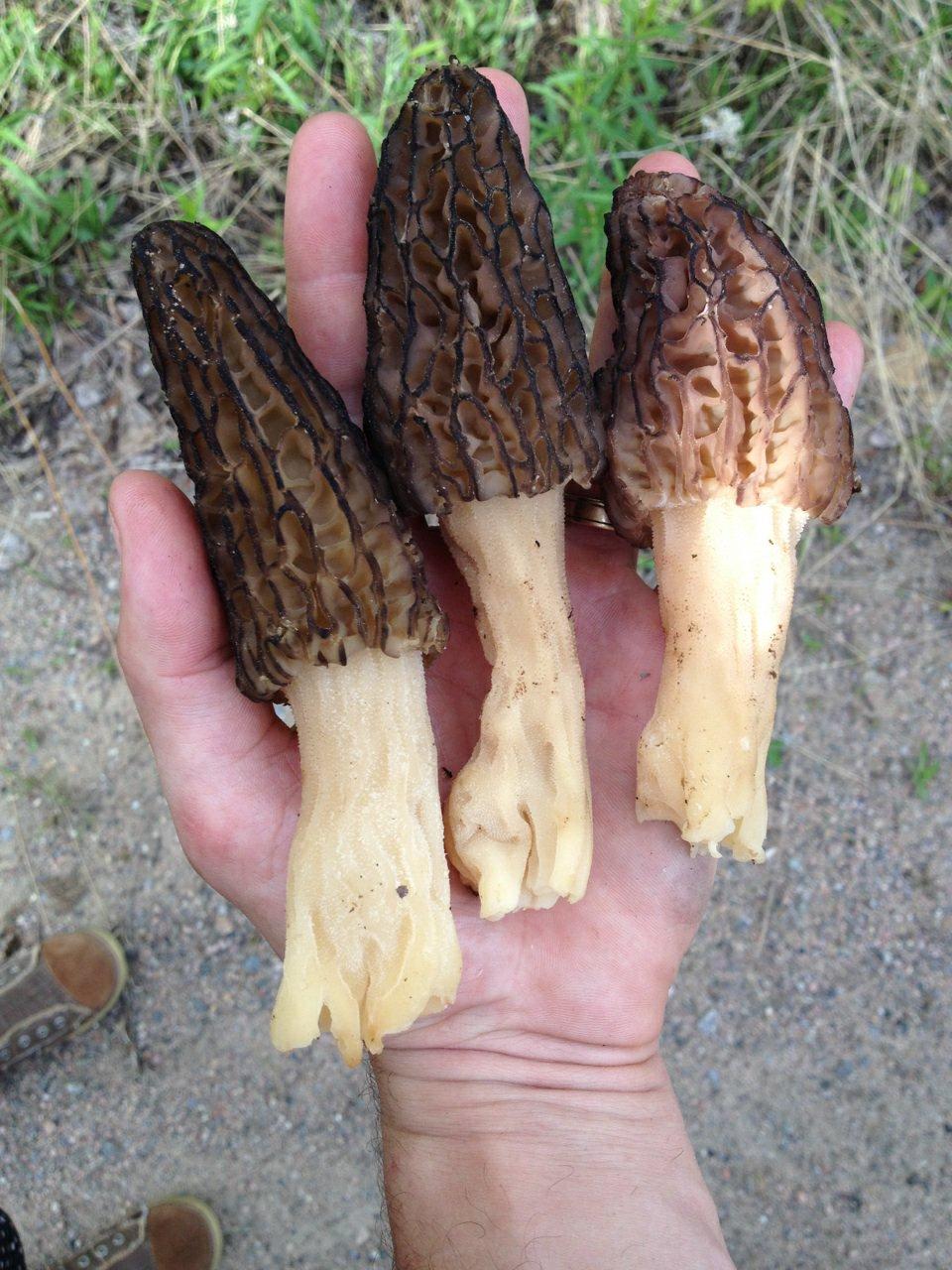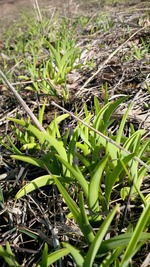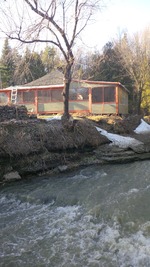Entries in Wild edibles in season (15)
Têtes de Violon
Têtes de violon(Fiddleheads)- pur délice de printemps
Nancy Hinton, Les Jardins Sauvages

Et oui, c’est déjà bientôt ce temps de l’année! L’arrivée des têtes de violon est toujours un moment festif chez nous, vedette du printemps - notre premier légume vert de terroir, si nutritif et délicieux quand bien choisi et apprêté. Ce qui débute la saison de récoltes et de bien manger local plus facilement, yé.
La bonne nouvelle c’est qu’il ne faut pas avoir peur de ce bon comestible forestier! Malgré la mauvaise presse et controverse dans le passé. On dirait qu’on recommence à chaque année avec éducation face à de l’information confuse qui circule, quand ce n’est pas si compliqué. C’est juste une question de qualité, fraicheur et de cuisson. Les seuls cas de malaise documentés ont été dû à de la consommation crue et sources particulières/inconnues. François en cueille dans nos sites de façon durable sans probleme depuis tant d'années. (37 ans officiellement)
Les têtes de violon nous offre un cocktail impressionnant de nutriments comme les Vitamin A et C, des anti-oxydants et minéraux essentiels (le fer, calcium, magnésium, potassium, Cu et Ma), protéines et fibres.. Elles contiennent également une molécule qui peut être indigeste – le ptaquiloside, mais qui est soluble dans l’eau et dénaturé par la chaleur. Alors si lavées et cuites, il n’y a pas de soucis! Et vu qu’elles poussent au long des rivières, cela protège contre les bactéries aussi.
Aussi, la réalité c’est qu’il y a beaucoup de variabilité de qualité et de fraicheur sur le marché, incluant beaucoup de marché noir et de cueilleurs improvisés, opérant en dehors de chaine de réfrigération et normes d’hygiène et salubrité, sans traçabilité. Souvent ce qu’on trouve à l’épicerie par exemple est un lot qui a été dompé sur le marché à bas prix comme les commerçants préfèrent, parce que le cueilleur sans chambre froide et réseau veut s’en débarrasser. Un cueilleur/entreprise enregistrée avec des normes et couts d’opération ne peut pas compétitionner le marché noir sur le prix, mais certainement sur la qualité.
Bref, on a simplement à s’assurer d’une bonne source fraichement cueillie et bien entreposé, les laver et cuire dans beaucoup d’eau bouillante. Il ne faut pas les manger cru, c’est tout!
Cuisson : Avec une belle qualité de têtes de violon (comme les nôtres) et suffisamment d’eau dans le chaudron, 5 min dans l’eau bouillante c’est assez pour que les têtes soient cuites au centre et tendres... Avant des introduire à vos recettes. Fiche de cuisson sur notre site.
(L’histoire de cuisson à deux eaux est superflue à moins que vous ayez un tout petit chaudron ou une source inconnue ou vous êtes perfectionniste visant le maximum de couleur vert et contacte d’eau avec minimum cuisson, vraiment pas nécessaire pour la digestibilité ou la délicieusité). Il y a un temps qu’on le suggérait par précaution, mais suivant ma recherche et autant d’années d’expérience depuis, j’ai conclus que c’était bien ok de sauter cet étape.
On peut les manger froides en salade après une première cuisson, mais elles sont encore meilleur chaudes. De plus, on va souvent les mettre à la poêle après avec un peu de beurre monté (beurre + eau) et assaisonnements, alors une cuisson de plus... De toutes façons, elles sont meilleures un peu plus cuits qu’‘aldenté’.
Comme la plupart des légumes verts, elles aiment l’ail, et un peu de bon gras, par exemple, une bonne huile d’olive, noix ou de tournesol, le bacon, viande et umami, ainsi que les recettes asiatiques avec tamari et sésame, ou curry-coco. En omelette, pâtes, en accompagnement, on les utilise comme une asperge ou haricot vert.
Cueillette – astuces/ à quoi faire attention
Si on est assez chanceux d’en avoir sur notre terrain ou autre terrain privé avec permission, on peut les cueillir soi-même en faisant attention. Les têtes de violon poussent dans les lieux humides en forêt, aux bords de rivière et zones inondés. Fin avril début - mai au Québec. Il faut s’assurer de bien identifier l’espèce de fougère comestible (Matteuccia struthiopteris) car il y en a plusieurs, avec l’aide de personne expérimenté et livres de référence comme ‘Plantes Sauvages Comestibles’ de Fleurbec.
On les cueille à la main (sans couteau) quand juste sorti de terre (pas déroulé), et seulement 2-3 par plant; on laisse toujours plus qu’on cueille. Ensuite, il faut les laver pour enlever la pelure/les écailles brune à grande eau. Après, on les réfrigère jusqu’au moment de les cuisiner.
Idées - Recettes :
Notre façon préférée pour les têtes de violon est assez simple : Après la première cuisson à l’eau bouillante (5min), on les met à la poêle avec un peu de beurre/huile de choix, de l’ail et ‘épices à steak’; ensuite quelques gouttes de tamari, de sirop d’érable et de vinaigre de cidre. On les fait déguster comme ça, mais cette préparation fait un bel accompagnement pour poisson, viande, salade composé (style niçoise), pasta style primavera ou carbonara, pour garnir un poke bowl, etc...
Au resto, on les cuisine de plusières manieres selon le menu, et on fait toujours de la soupe verte, une chaudrée cremeuse avec bacon aussi. En saison, on fait nos reserves - en marinades et blanchies, congelées sous-vide pour l'hiver..
A la maison, on les aime bien en frittata, en wok de légumes et nouilles avec huile de sésame et chilli-crisp, ou en salade tiède. Je fais des vinaigrettes pour Jardin des Noix – ‘Europe’ (à l’huile de noyer noir) et ‘Asie’ (à l’huile de noisette), et les deux sont délicieuses sur les têtes de violon!
Une autre recette favorite s’agit d’oignons sués avec du lard/bacon, et un peu de bouillon/eau, sel & poivre (et bouquet garni typiquement Québécois avec laurier, thym ou sarriette & clou (ou épices à tourtière)), cuits doucement, assez longtemps. (Façon bas-du-fleuve)
Il y a plusieurs recettes sur note site. https://jardinssauvages.com/guides-fiches-de-cuisson/
Bon Appétit et Bon Printemps!
Wild Kombucha Sauvage
Kombucha Sauvage
Boire la nature
Wild Kombucha Drink Nature
Thérapie Gourmande et Rafraichissante de notre terroir forestier
Refreshing Plant Therapy, Local & Wild
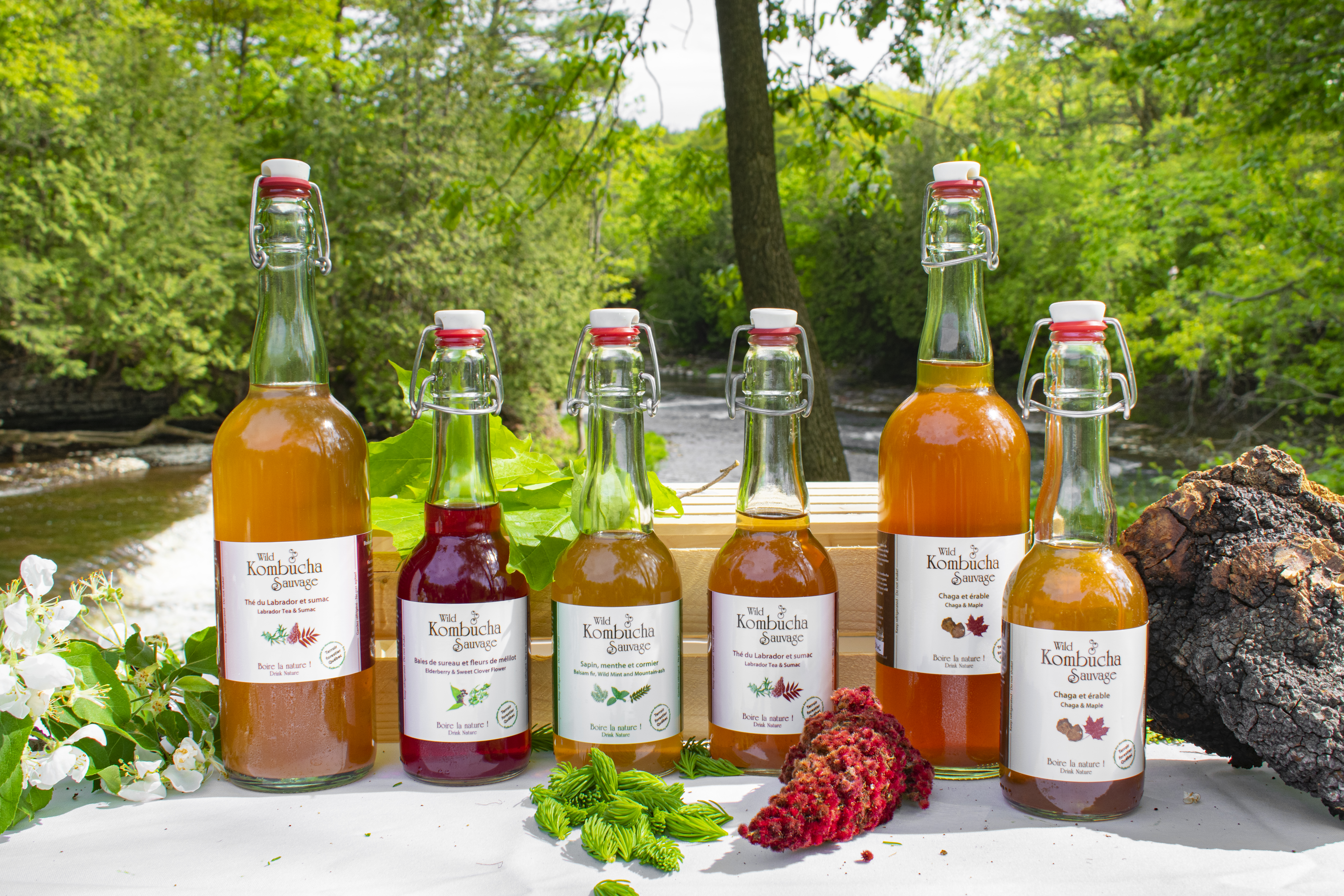
Thé du Labrador-Sumac ; Baies de sureau & Fleurs de mélilot
Sapin, Menthe et Cormier ; Chaga-Érable
+Saveurs saisonnières : Fraise-Foin d’odeur ; Pomme-chicoutai ;
Framboise noir-Anise ; Menthe- Bleuets sauvages..
Disponible à notre kiosque au Marché Jean Talon à l’unité (verre/375ml/750ml) ou sur commande à la caisse/keg
info@jardinssauvages.com ; 450-588-5125
http://jardinssauvages.com/index2.php?nom=Kombucha_Soda
Les Jardins Sauvages, Gastronomie Forestière depuis 1986
François' tomatoes, and a few summer recipes
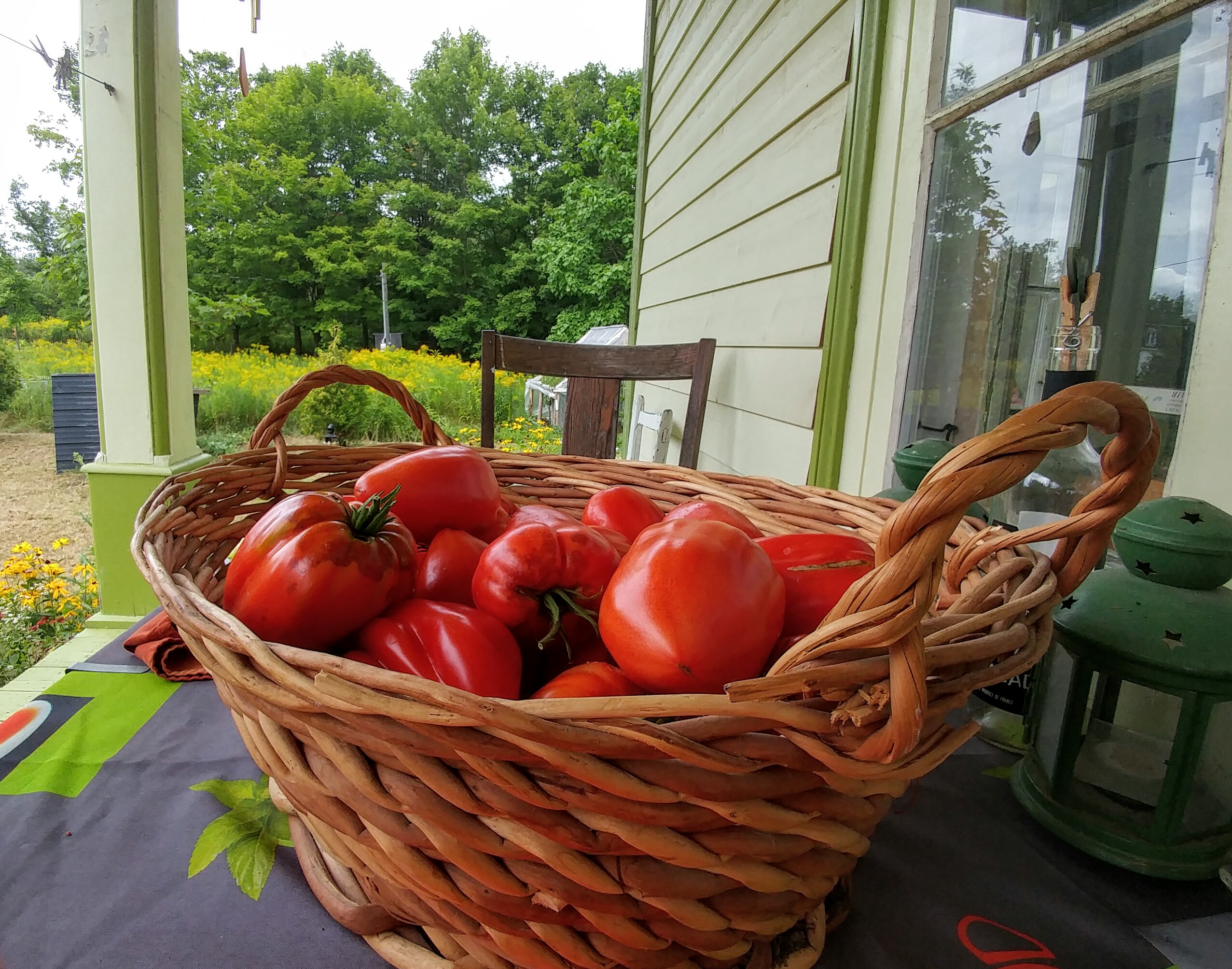 We may as well talk about tomatoes since there isn’t much going on in terms of local mushrooms. What a crappy season so far. I mean we’ve had a few good harvests but we are not meeting the demand at the market, and with a trickle for the restaurant menu, I haven’t started putting up. When you consider that I typically process 2 tons of mushrooms for our year (to supply the restaurant and make our products), I will have to get started soon enough.. Pretty frightening. Fingers crossed.
We may as well talk about tomatoes since there isn’t much going on in terms of local mushrooms. What a crappy season so far. I mean we’ve had a few good harvests but we are not meeting the demand at the market, and with a trickle for the restaurant menu, I haven’t started putting up. When you consider that I typically process 2 tons of mushrooms for our year (to supply the restaurant and make our products), I will have to get started soon enough.. Pretty frightening. Fingers crossed. 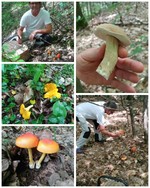
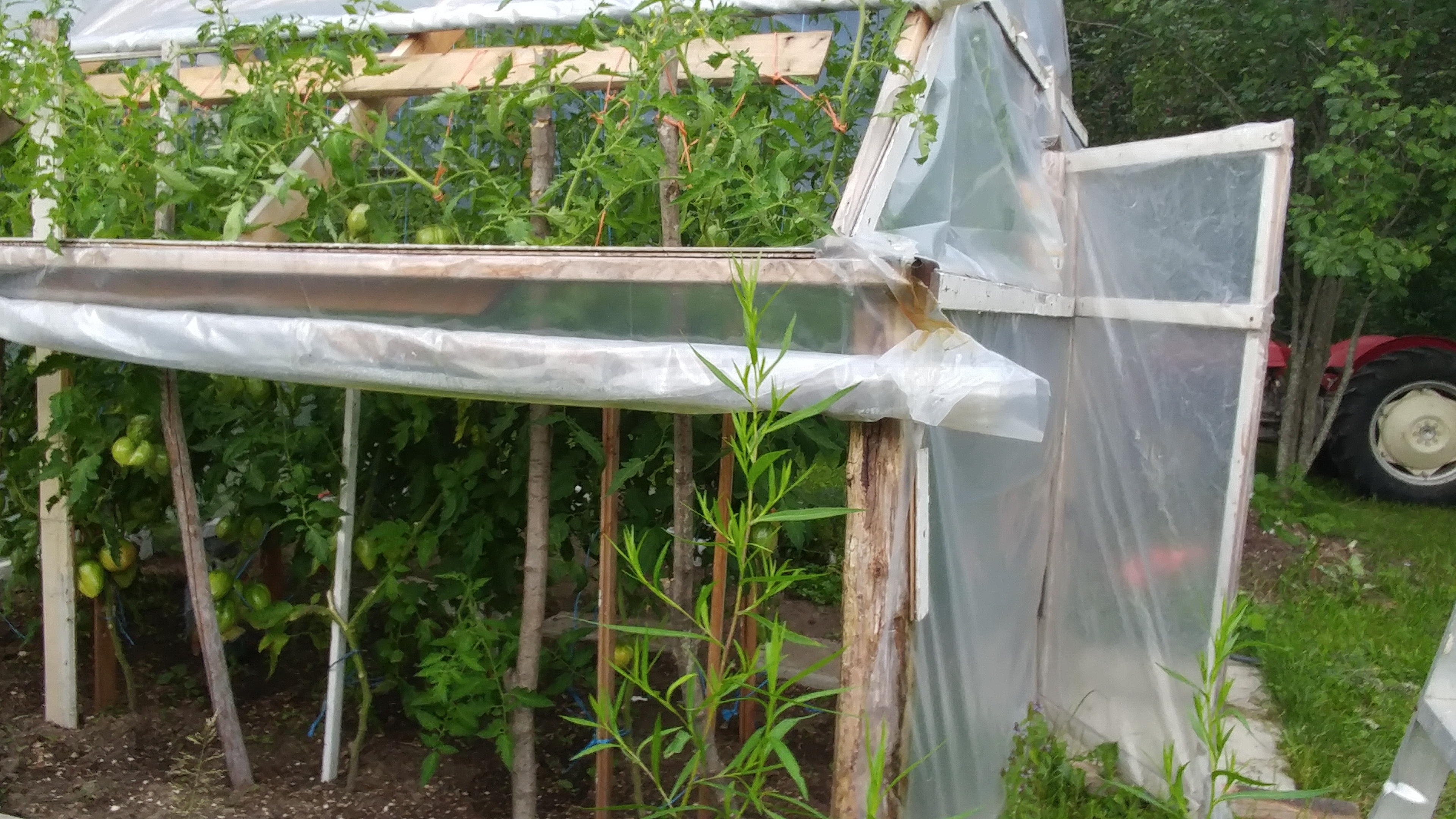
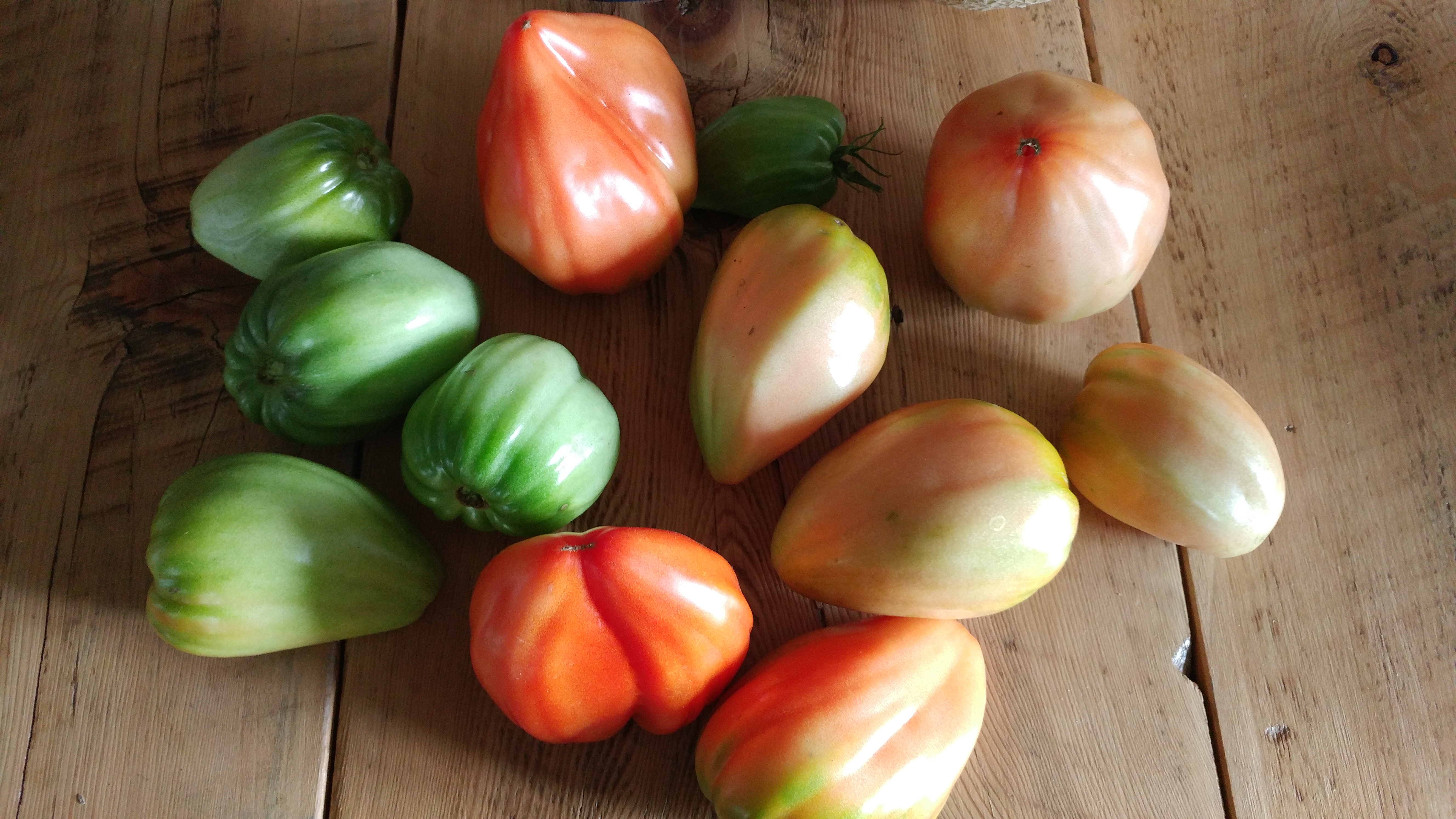
So anyway, back to the tomatoes. Anyone who knows us (or follows me) has heard of François’ famous tomatoes. They are an old heirloom variety whose name eludes us, from seeds passed down generations in Pasquale’s, (one of his Italian mushroom pickers) family. His great grandfather brought them over here like a century ago. François kept the seeds from the tastiest of his specimens and started them this winter, moving them into a greenhouse in the spring, and he lovingly tends to them every day with water and suckering, tying them up (they are 9ft tall!) and etc. He has planted some in the garden too and distributed seeds to other gardeners as well, in hopes to keep the variety alive.

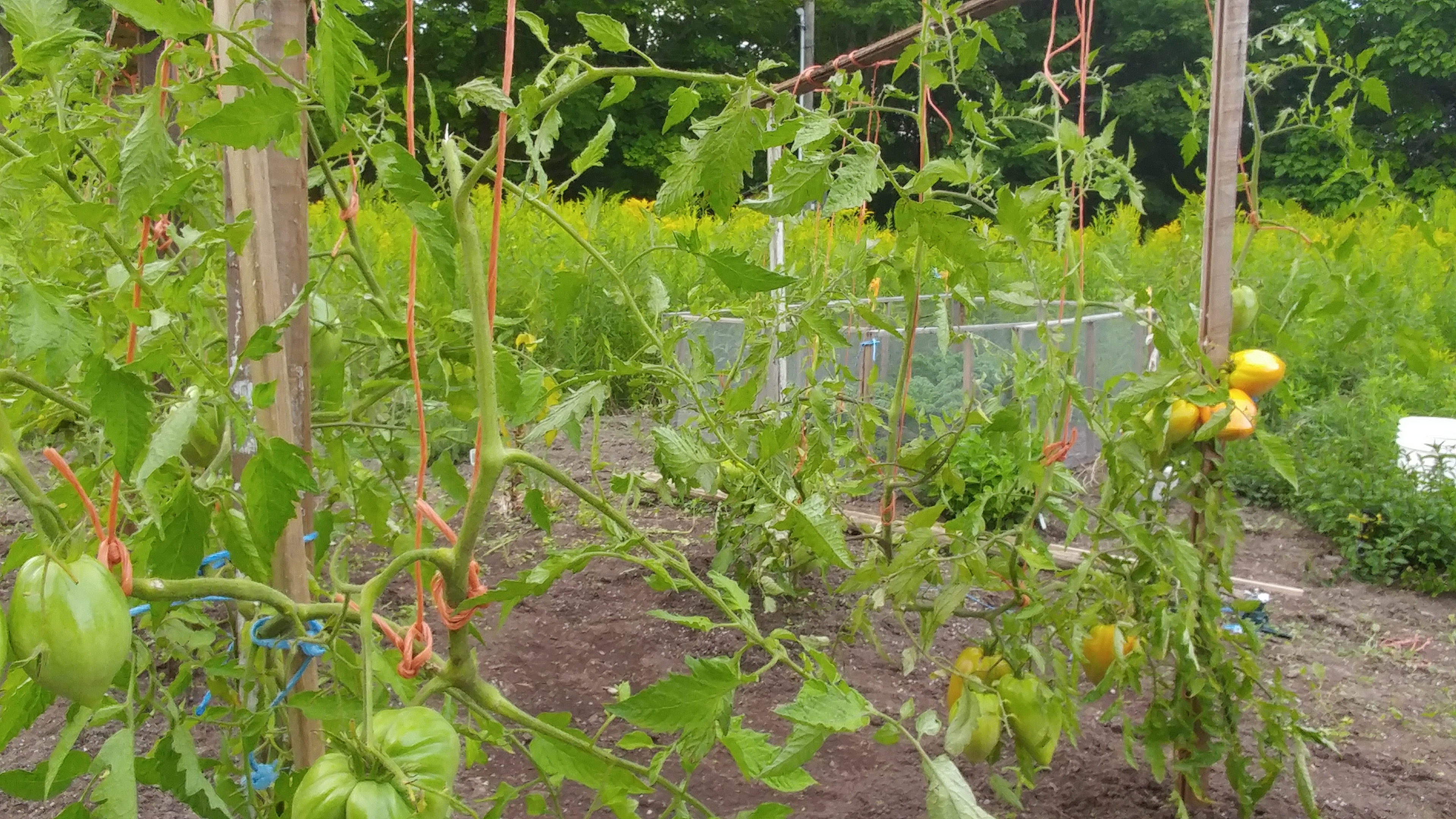
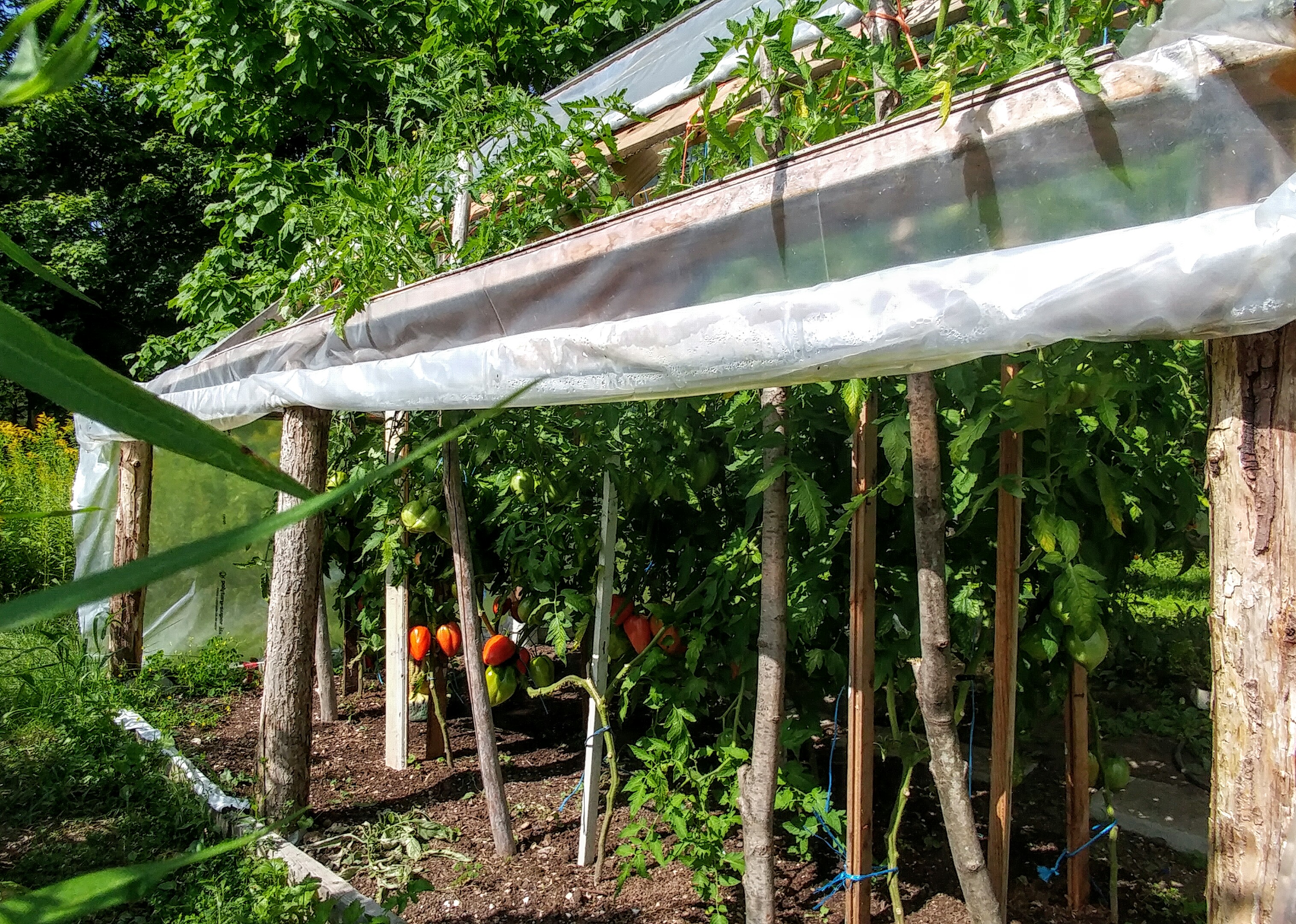 Greenhouse vs field, the taste test is on..
Greenhouse vs field, the taste test is on..
 Proud green thumb
Proud green thumb
I can’t tell you how important his tomatoes are to him, and hence what an exciting time it is in our household now that they are finally becoming ready. He lays them out on the counter in order that they will be eaten and for different uses.. Woe and behold if I take too many to the restaurant or if I chop up the one that was meant for a sandwich, or yikes, slice it ‘the wrong’ way - Watch out for the St-Roch tomato police!
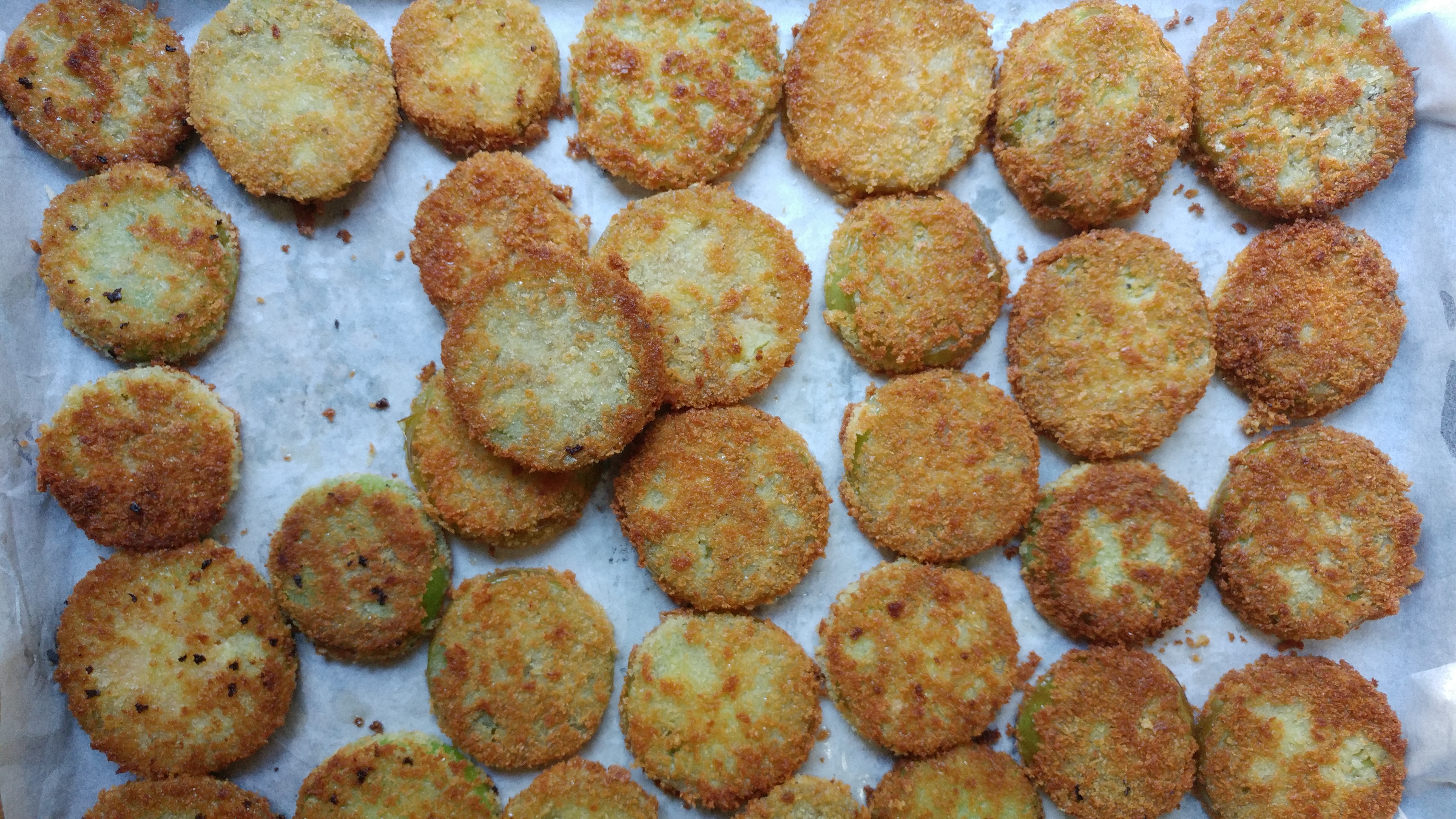
The first dish was of course Fried Green Tomatoes, which has become an annual ritual since we started making them (http://soupnancy.squarespace.com/blog-journalessays/2009/10/7/fried-green-tomatoes-finally.html), François just adores them. And besides, what else are you going to do with green tomatoes. Now that they are ripening, we are eating them in salads and salsa, with pasta and fish. They are meaty, not many seeds buy juicy, sweet and tomatoey, with a bit of tart. I like some acidity but François expects them to be succulent sweet and is banking on the garden ones.
He apparently has tomato tarts and pizza on the agenda, as he has ordered his dough (from me)..
At the restaurant – 1st entree of the moment: Fried green tomato with ripe and smoked tomato, corn, cucumber salsa, sea spinach and sea asparagus, crinkleroot lovage yogurt dressing, smoked eel, bee balm 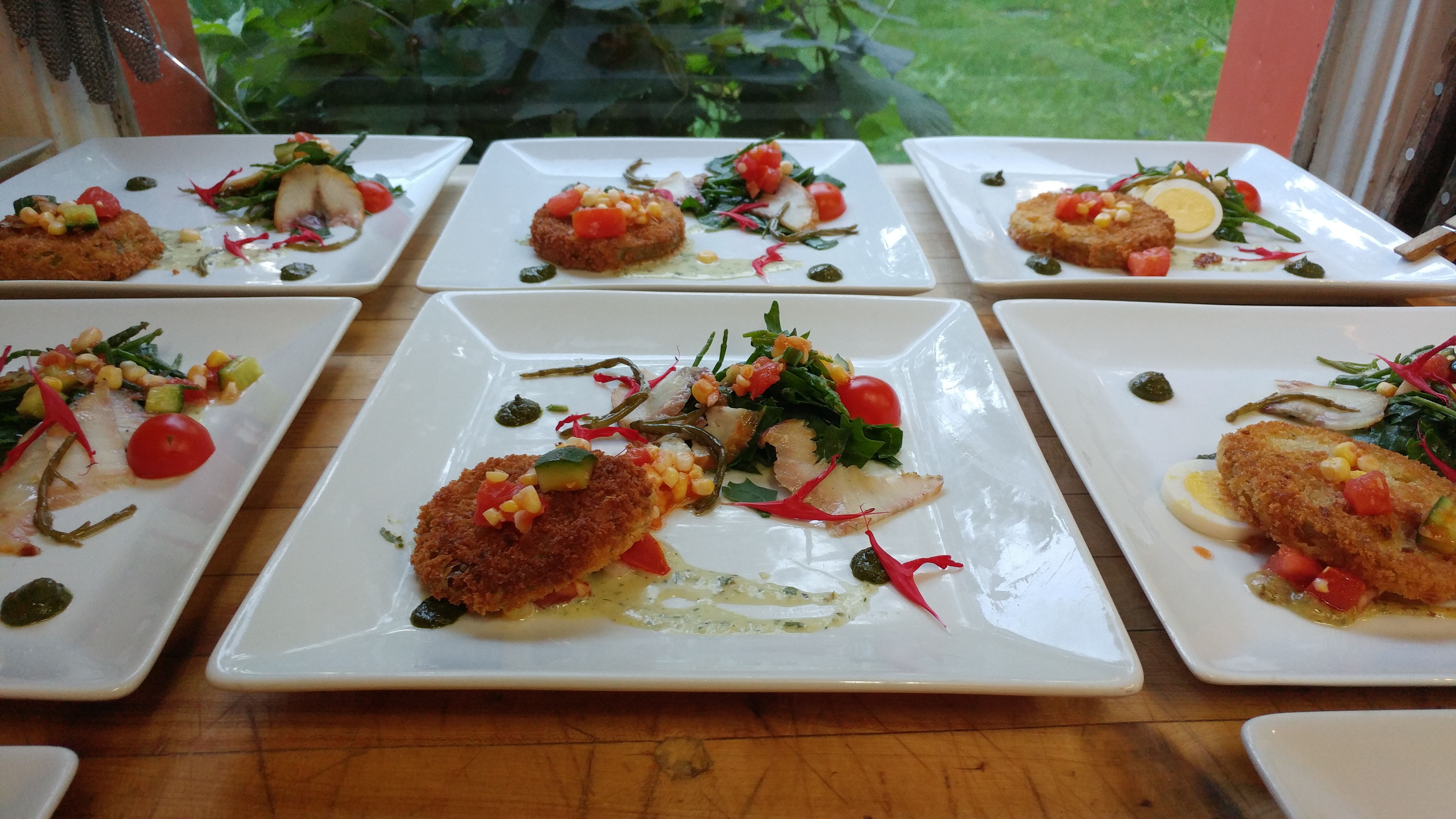
As the harvest really explodes later this summer/fall, I will be canning, smoking, making ratatouille and ketchup, etc..
But it’s not all about tomatoes or even the wild edibles, with the corn and beans, peas, favas, zuchinni and peppers, garlic, kohlrabi.. Lettuces, herbs, Plums, melons and peaches.. Not to mention the wild blueberries! And it will only get better in the month ahead, alongside the mushrooms. September is the best month of the year for food!
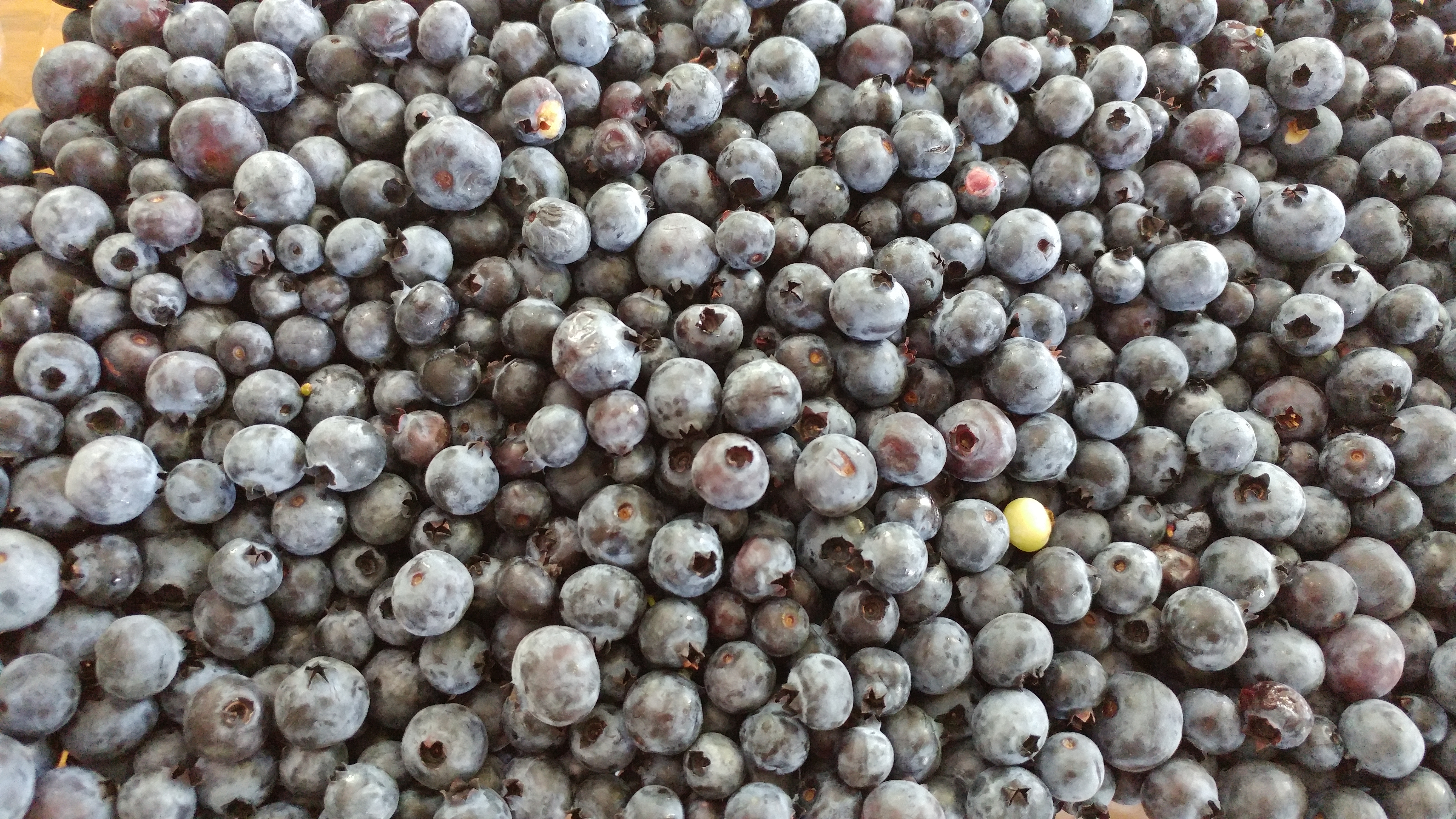
Some other summer hits:
A vegetable stew thickened with bread: ribolita - panzanella meets ratatouille, just a different delicious way to use the garden bounty or what’s hanging out in your fridge. Stew onions with celery/leek, peppers, add zucchini and whatever other veg you like (corn, beans..) Herbs and spices, A bit of white wine and stock or just tomatoes with their juice. At the end, throw in some croutons or dry bread, season and serve on salad with a good oil, aged vinegar and cheese shavings. Good as is or as an accompaniment to sausage, chicken or steak. At the restaurant, I was serving it with confit rabbit. 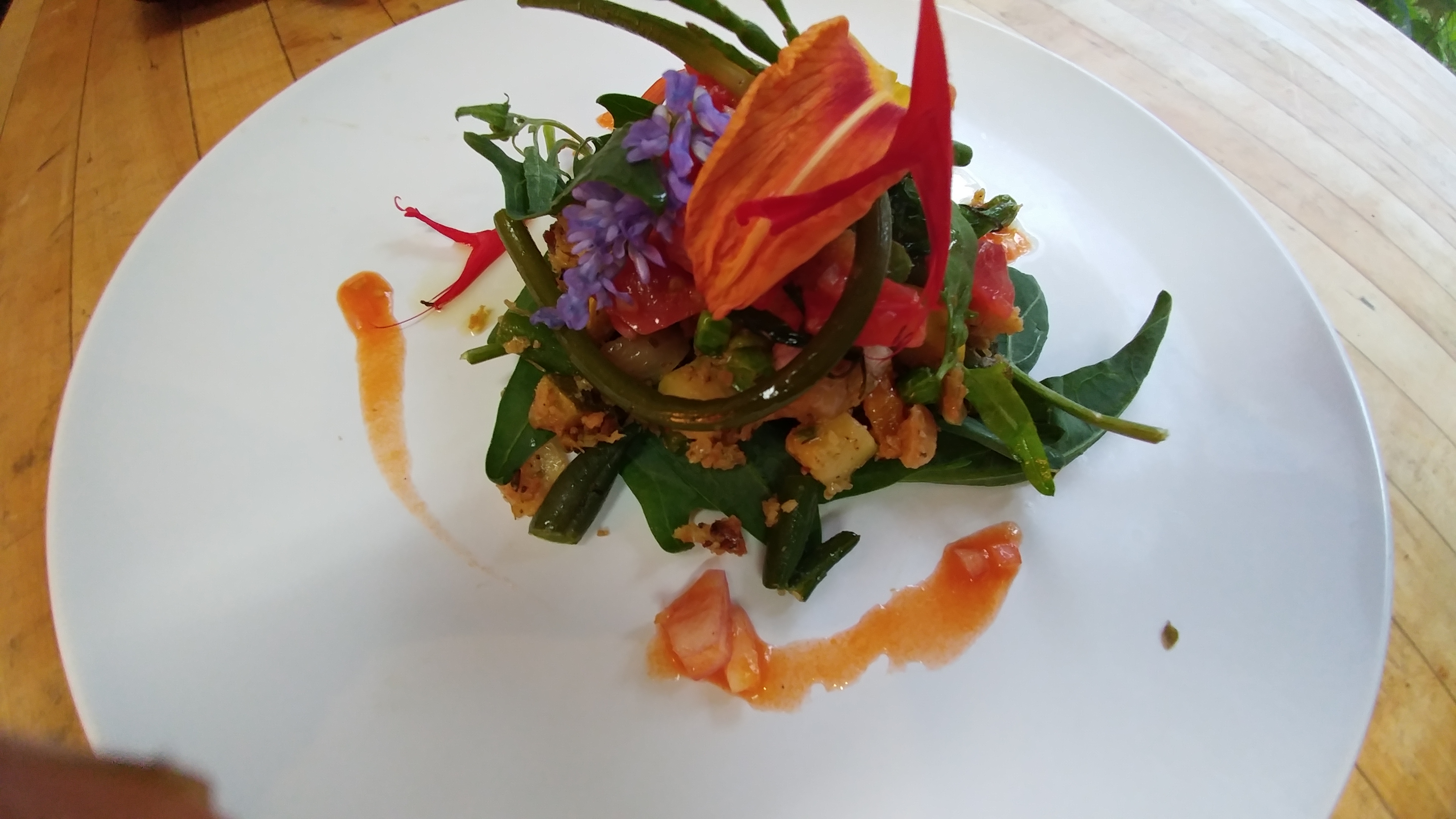
Fleur d’ail (Scapes) as a vegetable and as a condiment
In July when it’s scape time, we put them up for the year, alongside the wild stuff, a raw, green garlicky pesto. But it’s a beautiful time and a 2-3 week window (one for picking one, 2-3 for storing), when you can eat the scape as a vegetable, like an asparagus or green bean. It takes a 5 min. Boil. It is tender when it loses its bright green, sorry. Mildly garlicky, delish. Here the raw pesto is tempered into the hot potato mash, and the cooked scapes are a garnish. Alongside chanterelles which are in season at the same time. Just missing the corn, which would be perfect now. 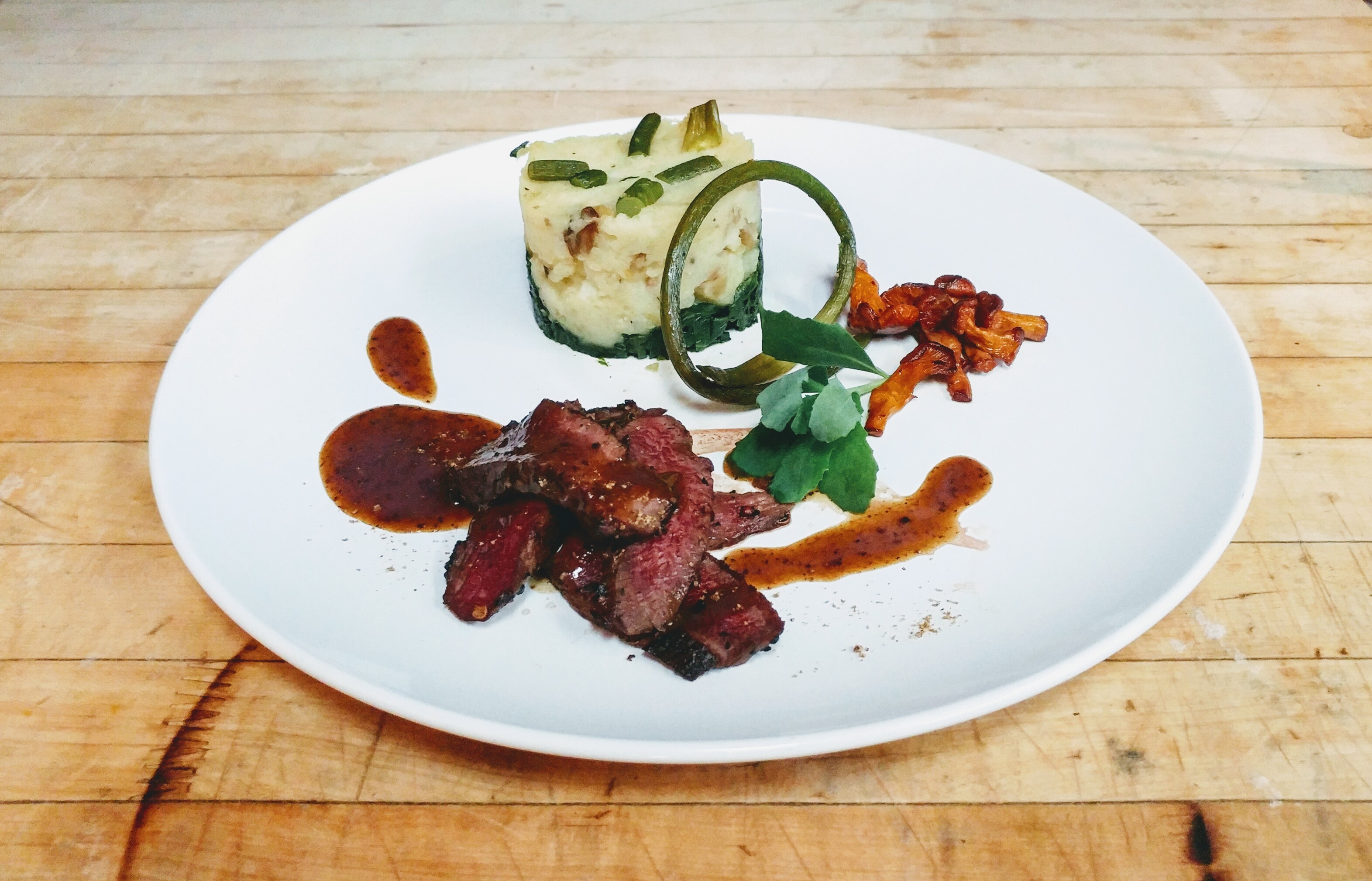
Vichyssoise (Stinging nettle)
Like a Parmentier or any puree/ green soup thickened with potato (so less cream). With stinging nettle and sea parsley, this soup is delicious, but it could be/is with many greens. I make a seasonal green soup with what is abundant, always good. Not only delicious, but nutritious. Served cold on a hot day or hot the rest of the time. Just a basic soup with onion, leek, celery, a touch of wine or vinegar, stock, herbs and spices, potato. Add wild greens. Finish with cream, milk. Tweak with salt, pepper, spice, acid, maple syrup.
Add a little garnish like this: cucumber, radish, lovage, sumac to lighten it up, or it could always be another to make it more hearty like bacon or smoked duck.
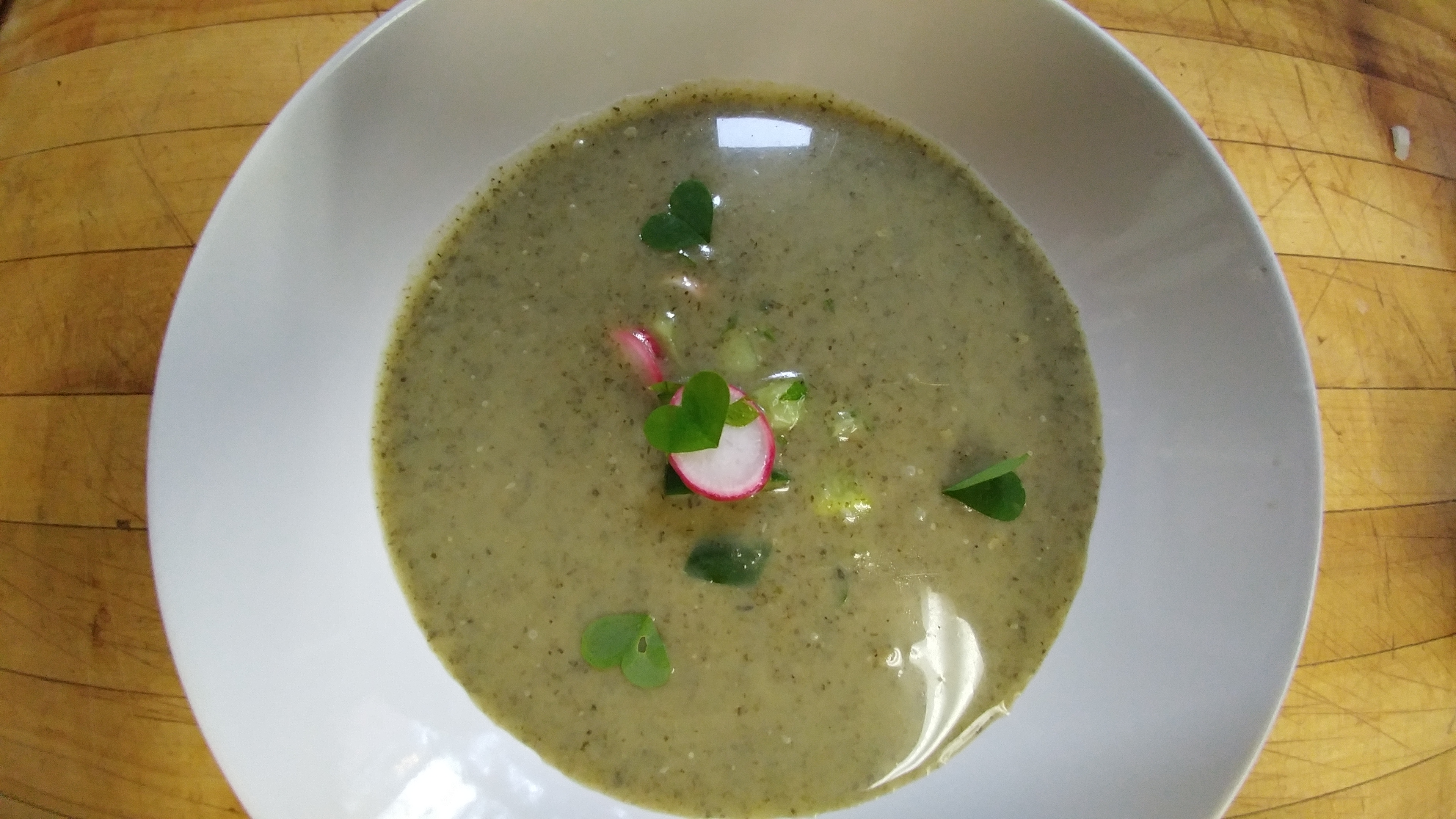
Mushrooms or not, it’s time to be hitting the market (and/or garden) and cooking up a storm!
 Lobster mushroom and lobster bisque risotto with beach peas, sea spinach and sea scallop
Lobster mushroom and lobster bisque risotto with beach peas, sea spinach and sea scallop 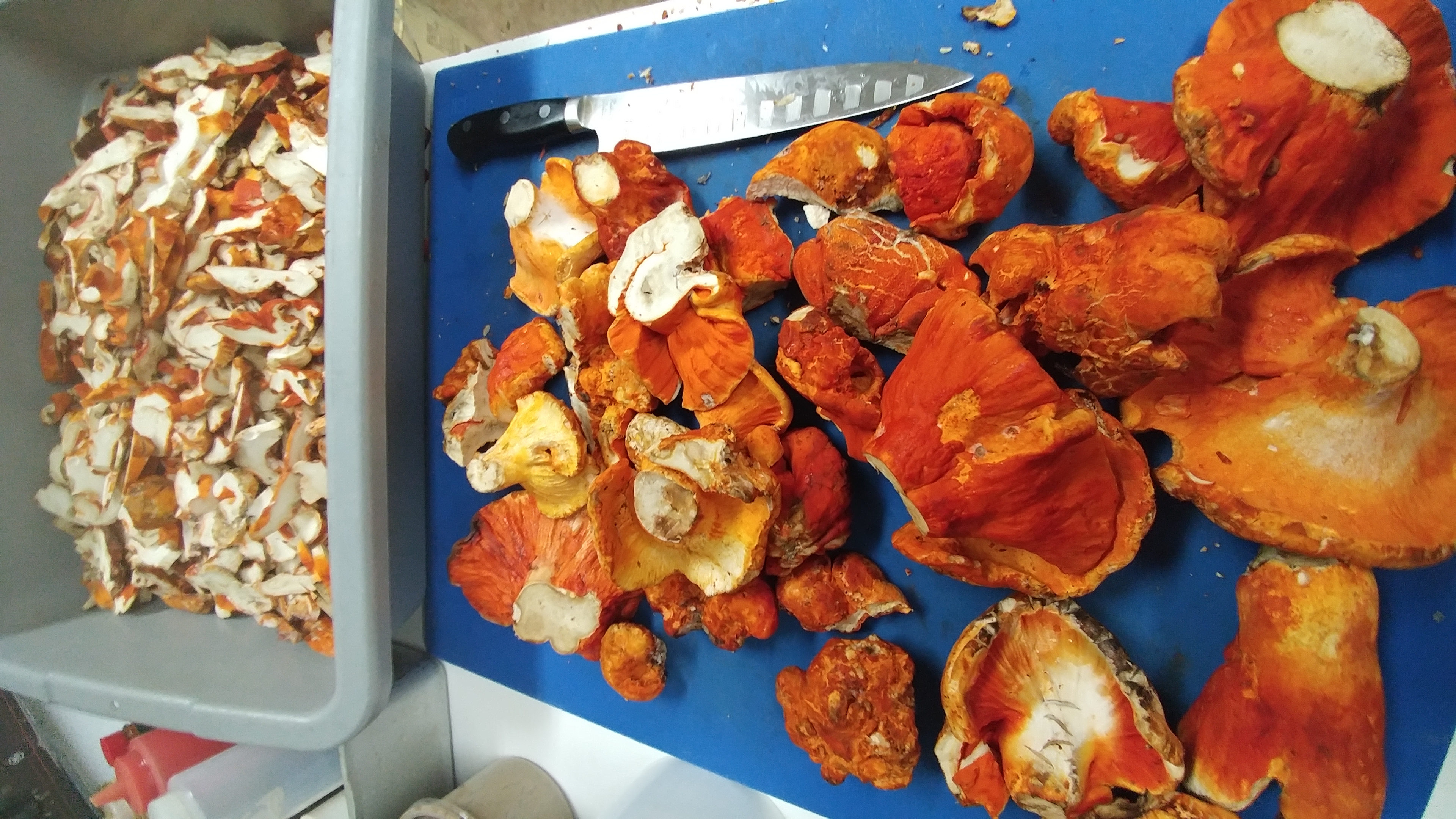 First significant harvest of Lobsters to put up
First significant harvest of Lobsters to put up
Spring meets Summer, Foraging issues and guidelines
Spring meets Summer, finally!
Although it’s still technically spring, it’s starting to feel a lot like summer. A deep, lush green abounds, a symphony of birds chirping, and yup, the mosquitoes are out in full force.
Our spring rush of harvesting shoots and fiddleheads is over. It’s always a mad dash to seize the short window and make the most of it. With a slow, cool spring, the greens were at their best - mild and crisp, delicious.
 François' 'shade' fiddleheads
François' 'shade' fiddleheads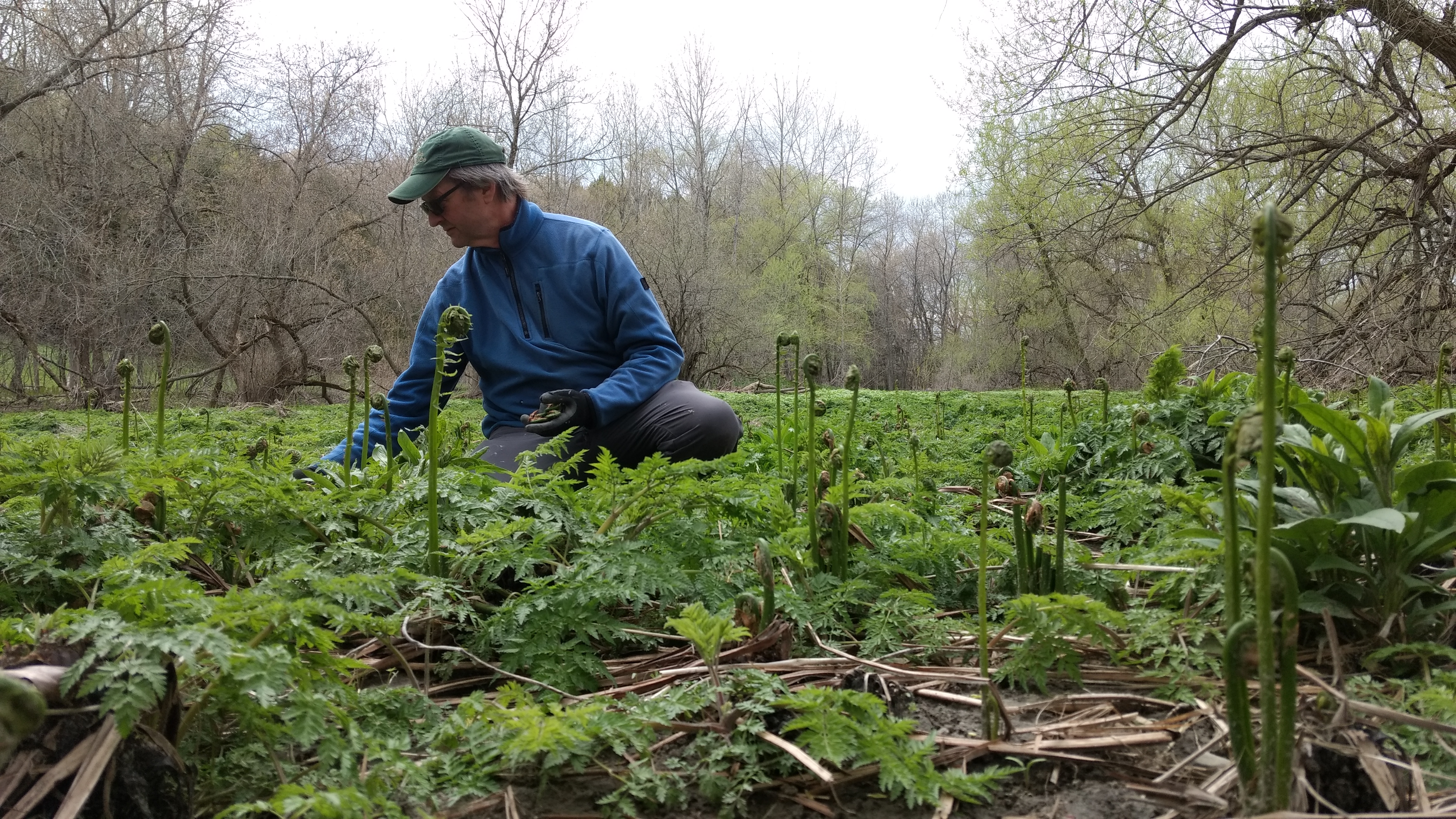
 erythrone/trout lily
erythrone/trout lily
Now, the early season stars like Trout lily, Dandelion, Spring Beauty and Linden have gone, as Stonecrop (live-forever), Daisy and Violet take their place. There is stinging nettle, garlic mustard, sheppard’s purse, wild chives and such.. as the buds appear, the edible flowers start to bloom and first marine greens pop.
It was a great morel season.
I couldn’t help but notice how many people were out there foraging and posting pictures of wild edibles this spring. It is clear that this is a trend that is only growing.
Which is great and NOT.
It’s natural that once awakened to the delights of the forest that passionate eaters and cooks want to get out there themselves. I remember my beginnings at L’Eau à la Bouche with Anne Desjardins where I met François the pioneer of foragers, how thrilling it was to discover these new ingredients. I was lucky to team up and build on his experience, taking the wild thing a step further than the chefs he'd worked with before in the Jardins Sauvages kitchen. But being leaders in largely uncharted territory meant that we had to figure a lot out on our own. Just that a certain plant is edible and best used a certain way is taken for granted now, while many years of research, tests and samples given away lie behind. Not to mention the miles walked and free labour on François' part going back 30 years. Today, it seems that every other menu resembles one of mine from 10 or 15 yrs ago, with game, wild greens & wild flavours everywhere, back when I was the only one with sweet clover or wild mushrooms in my desserts, ha. I knew we were onto something, but who knew it would ‘mushroom’ so.
For sure foraging is awesome in so many ways; it doesn’t get much more terroir, fresh and local than that. But the thing about foraging, is that it’s trickier than it appears! It is not as easy as walking through the woods and filling your basket, it is not 'free'. You need land, and knowledge, a due respect for nature and nuance, lots of time and patience, before actually putting in the hours and doing the work. Finding your spots, being there at the right time, getting down and dirty on your hands and knees with the mosquitoes. It takes more than a day or a season to learn the basics, plenty of books and time spent in the woods. Way more than a google search or utube video, say. People these days want to go too fast. It’s not that I want to discourage eager enthusiasts... But Please! I just wish everyone would be more mindful and cautious. It’s for the plants, the future and one's own sake, not only sustainablility and safety, for deliciousness too.
Foraging primer: Bottom line, Don’t touch unless you know what you’re doing..
Which means How, When and Where.
First of all, know that what you’re picking is indeed edible (there are many look alikes). Ensure that it’s a healthy population. It depends on the microclimate and age of plant population. You need to know the cycle of the plant/how hardy it is before knowing how much you can take. That’s why being in the same spots, seeing the impact of your harvest each year is so important.
Don’t rip out roots (in general). Prune.
If you pick, don’t let it show, as in you’re leaving way more than you take, little trace. Unless you are weeding your garden or in a site with an invasive plant you know well.
Be careful/don’t pick species that are slow to reproduce or endangered: Wild garlic, Wild ginger, Crinkleroot, Milkweed..
And some need to be mature enough, and then just trimmed - like sea asparagus (salicorne, samphire), otherwise you might kill the plant. This is an issue now when it is still several weeks too early to pick salicorne anywhere in Quebec. Yet, I see it on menus.
The ‘weeds’ you can worry less about, Go!: Lamb’s quarters, Nettle, Garlic Mustard, Sheppard’s purse, Purselane, Amaranthe..
And then in the kitchen, they need to be washed, and cooked properly! Some need to be cooked throughout: For instance: Fiddleheads, Milkweed, and most wild mushrooms. Wash well and boil 5min+. Less touchy veg like beach peas, goat's beard, and leafy greens like nettle might only require 1-2min. For mushrooms, a braise is better than a sauté, count 5-20min. Some greens are better raw, but most are better cooked even if slightly. All are super healthy ingredients, but can be toxic, you can’t just wing it. I’ve seen sprouts of toxic plants decorating plates in Montreal.
Don’t give wild plants a bad name by serving anything up because it sounds cool, as little do you know it might be of sketchy quality, often like those on the black market or picked without experience.. For example, dandelion is only good if picked young (before flower) in the morning; most greens like live-forever only in shady, humid conditions; garlic mustard is only yummy young/early season and same, bitter in dry conditions. Same with beech chickweed. Etc. Where, when and how was it picked/stored etc.. is key to whether it will be yummy and not give anyone a belly-ache.
With many wild plants and aromatics (herbs/spices), it’s a question of dosage.. As with nutmeg, basil or rosemary, all of which can kill you if you eat too much. The difference between delicious, medicinal and toxic is in the dose. Normally nature is well made, as in you won’t use anything potent in huge quantities - the difference between a vegetable and an herb, a stock or a sauce. For example, be careful with mélilot/sweet clover flower, sweet grass, conifers - less than .1%. . Oxalis (Lady’s sorrel), like kale and rhubarb leaves contains oxalic acid, which is hard on the kidneys. And so on.
(See more picking tips and photos/links below..)
Whether picking or not, Chefs using wild ingredients need to be responsible for their source or purchases! (See Black Market blurb below) And you can participate. There is a conference on the commerce of PFNL (wild edibles) and the development of guidelines, with chefs and journalists invited (June 14th in Quebec City), the first public meeting of the type, there will be more. It’s about developing the industry further, but in a structured and sustainable way. See below.
Rules and Regulations – they are coming, but it’s complicated
This explosion of amateur foragers and start-ups might be a plus for the economy but problematic for sustainability of the resource and market, quality and safety. Making some sort of regulation has become necessary. Which is what groups of people in the industry and levels of government are currently working on but it’s incredibly complex. Between the interests to develop the forest beyond lumber, putting people to work in the regions, sharing our heritage while balancing what is possible with respect to nature and the realities of the market, labour, what is doable and fair when it comes to enforcement... Quotas, permits?
It’s a big pain in the ass actually. We have no choice but to be implicated, because we care and have expertise to bring to the table, and obviously, it will affect us directly. Trust me, we would rather not have to spend so much time on all this debate and data for regulation because although we believe in it, I can humbly say it shouldn’t even apply to us. Because of all the careless people who ravage or innocently don’t know what they’re doing, we might be banned from picking and exploiting edibles we have plenty of on private property, picking sustainably in the same spots every year (for 30 yrs). Nonsense. No one even knew about most of these wild edibles until François put them on menus by introducing them to chefs.
Or like with ramps. We have a healthy population that we could easily sustainably put it on our menu from our back yard, but it’s illegal. If I chop up a few leaves as a soup garnish for 10 clients there is an inspector at my door. Meanwhile, chefs all over Montreal who do hundreds/thousands more covers have ramps on their menu, from where? No inspectors? So it should be illegal, but what difference does it make? Ideally, it should be legal but regulated.
Black Market Everyone likes a good price, be it at the market or from a picker coming to a chef’s door. This year (and last) at Marché Jean Talon, there was so much black market dumping for fiddleheads, that we had to sell at a loss to discourage them. Because these guys don’t have fridges or a legit business, pay no rent or taxes, no inspectors, zero traceability. Who knows where or how it was picked, stored.. They need to unload so sell at whatever cost, ie dump. Merchants buy and sell. Like with wild mushrooms too. So say this foraging guy decides to continue beyond a day or two, he needs to buy a fridge, register a business, have a clean locale that will be inspected, he will want a website and business cards, maybe an accountant etc. Soon enough he will charge more or bail. Which is what they all do, bail after crashing the market with questionable quality produce, even poisonous mushrooms. So that’s the future if things don’t change, a bunch of n’importe quoi.
Meanwhile, we have for years, sustainably and passionately brought wild edibles to the market (at the restaurant, to chefs and le grand public, in the cooking schools), offering tastings, given out cooking instructions, building the market, teaching. If people want to be able to buy wild edibles from a reputable source, the present scenario is not sustainable.
Marketing vs Truth Everyone has local, something wild or boreale on their menu. But often it’s Bullshit, a few spices and maple syrup while most comes from big suppliers, imported. The morels on the market in March (when every chef wants to put morels on their ‘spring’ menu) came from China. And often, the wild mushrooms and vegetables come from out west, Europe or China, the deer often from Australia; elderflower from an imported extract, sumac imported and very questionable in composition. Wild arugula out of a Costco box is imported monoculture, not the same species as our wild rocket. Just because it sounds wild and local doesn’t mean it is. It sucks to have to question the glossy menu local wild vibe at your hot restaurant. But I’m kind of tired of being the real thing seeing all the BS that doesn’t seem to matter. I’m done with being polite.
Its great that many people want to reconnect with nature, eat locally and explore new flavours. A richesse de notre terroir that naturally should be a part of our culture and traditions, as it largely was before everyone moved to the city and started destroying biodiversity. Now people are waking up to the treasures, but there is less to go around. I know there are many young people opening Boreale restaurants or bars, making gin and cocktail kits, etc with the best intentions, without realizing the issues surrounding the sourcing. Like no idea what 100kg of juniper berries or Labrador tea entails.
Hopefully, we can all move forward with wild edibles for everyone who cares!
Info about the Conference for PFNL guidelines, hosted by the ACPFNL https://www.acpfnl.ca/ Details here: file:///C:/Users/utilisateur/jardins%20sauvages/pfnl/Acpfnl/ACPFNL%20invitation%20AGA%20du%2016-05-2017.pdf To stay informed, the ACPFNL Facebook page: https://www.facebook.com/Acpfnl-Association-pour-la-commercialisation-des-PFNL-178644682180969/
Foraging primer Edible Manhatten http://www.ediblemanhattan.com/departments/d-i-y-departments/forage-or-harvest-a-spring-foraging-primer-for-the-new-forager/
Spring, ramps and fiddleheads http://soupnancy.squarespace.com/blog-journalessays/2015/5/5/officially-spring-2015.html
There are many photos with the plants identified in our albums on our Jardins Sauvages facebook page https://www.facebook.com/JardinsSauvages17/?ref=bookmarks too..
Summer wild edibles http://soupnancy.squarespace.com/blog-journalessays/2011/7/19/snapshots-july-2011-summer-wild-edibles.html
Our old videos:
Spring, trout lily https://www.youtube.com/watch?v=qUMfSfquRpU
Other early summer backyard treasures https://www.youtube.com/watch?v=7Alf1arm478
Wild chives and https://www.youtube.com/watch?v=1kL2ycqvu_Y&t=172smint riverside https://www.youtube.com/watch?v=7Alf1arm478
Stinging nettle https://www.youtube.com/watch?v=1kL2ycqvu_Y&t=172s
Foraging tips and recipes
With the current trendiness of local, seasonal food and notably wild produce, naturally many foodies and chefs are eager to have a go at foraging themselves. After all, it is a part of our heritage living off the land, a rural practical tradition that was slowly largely lost (luckily except for in my partner François’ family).
Wild edibles being our passion and business, (Les Jardins Sauvages a pioneer, thirty years in now), naturally we are delighted that people are curious and open to eating our terroir treasures; however, there is a downside to this trend.. Many among this new set however excited in theory are city dwellers and completely disconnected from nature; they are not afraid enough, or careless , wanting to go too fast without sufficient knowledge, or respect for nature and awareness of sustainability issues.
It is important to have some background information before attempting to forage on your own.
Equally, if you purchase wild food, you want to know that the seller is first of all certified with an official business, knowledgeable and respectful of nature, picking sustainably, mostly on private property if not owned then with permission. Especially restaurant Chefs who are dealing in larger quantities should take responsibility when they put foraged foods on their menu, ensuring that it is from a reliable sustainable source (paid for with bill). The increasing number of hacks and black market is dangerous on all levels not only in terms of sketchy product commonplace, but in terms of sustainability of the resource with no traceability (picked how, where, by who). Not to mention that without the overhead of running a business, these occasional pickers crash the market making it difficult for an experienced business like ours doing it right, working with the government and schools, dealing with inspectors and paying taxes etc. (and who paved the way to boot).. Awaiting regulation, the best we can do is keep doing our thing while educating..
I recently hosted a crew of explorers who were here for a forest cooking competition (Woods Greatest Canadian Explorer) in a survival type series of challenges (airing July 28th) https://www.youtube.com/watch?v=aIvl5CWwZdw . We gave them a crash course in foraging with many of the wild edibles on our property before they had their cook off using wild foods and regular camping gear and dry goods. When customers come to the restaurant for a workshop dinner too, these are the main points we share with them about foraging before they go out identifying and tasting with François.
Bonus below are also a couple of easy recipes that you can dress up or down, meant to be doable while camping.
Foraging Tips
Chef Nancy Hinton, Les Jardins Sauvages
Know what you’re doing!
Ensure proper identification. Don’t rely on only one book (especially with wild mushrooms).
Ensure proper picking, both for taste and Mother Nature. There is a specific way for each wild edible (how, when and where).
Some greens are hardy, growing like weeds in the right environment (like lambs quarters, garlic mustard..) while others have a slow reproduction cycle so can easily be endangered if over-harvested (like ramps/wild garlic, wild ginger, crinkleroot). Don’t touch unless you know the life cycle of the plant and that it is in a healthy population.
In general, don’t rip out roots. Prune tips or leaves from mature plants, leaving buds; leave young baby sprouts alone.
Leave more than you take.
Besides for sustainability, there is also a proper way to forage for deliciousness and digestibility. Some plants are best picked in the morning (say dandelion), others at noon (say some flowers and goats beard).. Some plants are tasty when growing in a moist humid shady wooded area, while bitter, even inedible in a dry sunny season or spot, as with live-forever, wild rocket and mustard, sea chickweed..
Keep in mind that many wild edibles need to be cooked, for example: fiddleheads, milkweed, most wild mushrooms. It is a good idea to wash your harvest. When cooking, follow your palette: If it is pungent, use sparingly like an herb; if it is mild, then use as a salad green or vegetable.
Don’t be in a rush. Be cautious, not stupid.
Books and google searches might be a fine help, but there is no shortcut for experience.. Time in the Woods is Key! The best way to learn about foraging is to get to know your property or a patch of land/woods nearby that you can visit often, observing patterns, trees and what plants/mushrooms grow where every year, including the impact of your harvest (if you have permission to pick.) Start with a few plants and mushrooms, get to know them well and slowly widen your scope every year.
Some wild greens/vegetables to explore without fear: Live-forever, trout lily, violet leaf, day lily, fiddleheads, lamb’s quarters, amaranth, garlic mustard, wood sorrel, sheppard’s purse, wild mustard leaf, wild celery/lovage.. Always keeping an eye out for familiar wild berries, wild mint and chives..
Some wild mushrooms to start with:
Boletes (A family of hundreds including Porcini with the sponge under the cap) – While not all are of interest, they are not dangerous.
Lobster Mushroom – characteristic red colour and shape
Chanterelles – there is only one ‘look alike’ and easy enough to differentiate
Oyster/Shelf mushrooms on maple trees. Most are good when young, avoid really old rotten trees.
Be afraid of very pretty picture perfect mushrooms – often the deadliest!
Fish baked with crinkleroot, tomato and wild herbs
Chef Nancy Hinton, Les Jardins Sauvages
4 portions
Ingredients:
500g fresh fish fllets (or 1x 2lb whole fish, gutted)
45ml Butter and/or olive oil
1 c (250ml) shallots or onion, sliced thin
60ml (1/4c) sliced wild garlic (or 30ml minced garlic)
15ml (heaping Tbsp) steak spice
125ml (1/2c) white wine
30ml (1 Tbsp) crinkleroot (or horseradish)
375ml (1 1/2c) diced tomato (1 can)
250ml (1 c) heavy cream
1.5L (6 c) wild greens such as lambs quarters, sheppard’s purse/wild rocket sprouts, mustard leaf, amaranth..) or spinach/greens of choice
60ml (1/4 c) wild herbs such as wood sorrel, garlic mustard leaf, lovage, ramp leaf, chives, angelica, yarrow.. (or dill, tarragon, basil/ herbs of choice)
To taste salt, pepper
To taste hot sauce or chili
Method:
The fish can be cooked whole and served off the bone too. It all depends on your camping set up and mood.
Sprinkle the fish with steak spice.
Heat large pan or pot on burner or fire, sweat onions in butter/oil a few minutes, add garlic and crinkleroot, then white wine, tomatoes and cream. Place fish in sauce and top with wild greens and herbs, season to taste. Cover and bake or cook gently for 15-20min or until just starting to pull apart. A whole fish will take twice as long.
For the simplest method: All the ingredients can be put in a covered pot on the fire or in an aluminum foil packet (en papillote)..
Wild Mushroom Rice bowl
Chef Nancy Hinton, Les Jardins Sauvages
4 portions
Ingredients
225g wild mushrooms (such as chanterelles, hedgehogs, lobster mushroom, young king or yellow boletes, black trumpets..), cleaned and sliced
45ml grapeseed or olive oil
15ml (1 Tbsp) butter
1/2c (125ml) chopped shallots or onion
30ml (2 Tbsp) wild garlic (or half as much garlic), sliced thin
10ml (2 tsp) wild ginger, minced
250ml (1c) long grain rice like basmati
125ml (1/2c) white wine
30ml (1 Tbsp) dried mushroom powder
375ml (1 3/4c) water or broth
To taste Spices (ex. clove, bay leaf, pinch thyme or curry powder..)
To taste salt and pepper
1L (4c) Mix of wild greens and herbs such as lambs quarters, dandelion, wild rocket, ramp leaves, day lily shoots, daisy, sorrel, mint.. (or say spinach, watercress and basil, coriander, mint..)
30ml (2 Tbsp) Olive oil
Optional splash sesame oil
100ml pickled mushrooms, fiddleheads, kimchi or pickle of choice
To taste Chilli/hot sauce
Method:
Sauté mushrooms in a hot pan with oil. Once they start to colour, add the butter and onions and turn down the heat to medium, cook a few minutes and add the rice, garlic and ginger, stir to coat the rice. Add the mushroom powder and wine, reduce slightly. Add the water/broth, season with salt, pepper and spices of choice. Cover and cook over low heat for 15-20 minutes, until rice has absorbed liquid and looks almost done. Remove from heat and let sit 5-10 minutes.
Meanwhile, toss greens and herbs with a good oil, salt and pepper.
Serve rice topped with salad and pickle.
Add a fried egg, tofu, cooked sausage, leftover chicken/steak or protein of choice for a more substantial meal.
Wild mustard greens, our November star
Wild mustard greens
Forager and farmer come together for a win-win project
http://www.journaldemontreal.com/2015/11/27/la-moutarde-sauvage-apprivoisee (in French)
You see, among a zillion other wild edibles, we pick wild mustard greens in fall. They taste like their name implies, of green and mustard, yet nutty, with a pleasant touch of bitterness. François refers to them as our ‘wild rapini’. In the wild they can be extremely pungent, or in humid, temperate to cold climate, in the right soil and shady conditions, wow - super delicious! Especially young, the sprouts, even full grown leaves can be so tender and soft, even buttery with but a delicate bite. They are tasty raw in a mixed salad, or gently cooked like spinach. Some years we had it on the menu and used it liberally, other years, not so much; we rarely bothered bringing it to market because among the other better known edibles, it could be a tough sell.
However, François has been wanting to exploit this further for a while. He couldn't help but think that it would be ideal and easy in a greenhouse, consistently customer friendly. He was a conventional farmer before he focused on the wild stuff, he knows that mustard is a good fertilizer. So..
He has been throwing around ideas with André Cormier for years, a nearby farmer who grows asparagus, tomatoes, cucumbers, greens, corn, squash.. Who has a lot of greenhouses. They have collaborated in the sense that he lets François pick wild greens in and around his fields (weed his garden) and has learnt a lot along the way, even eats some of it himself now. In fall, he grows a fertilizer crop like canola in his greenhouses only to enrich his soil. Finally they got it together this year and André listened to François and grew mustard.. For weeks, it went crazy, he was happy with the 'no sweat' rich green cover and high germination rate, François with the greens he could pick past frost. He was able to sell a bunch at the market if he was there talking about it and making people taste it. (Like most of our stuff, you need to educate, prepare and give a lot away in order to sell). Anyway, I'm happy that we still have local fresh ‘wild’ greens that aren’t blanched sous-vide on the menu at the restaurant. All in all, it appeared to be an experiment that showed promise. Plus, bonus chickweed (another good weed that I love) that in conjunction, stuck around a little longer.
Finally, the greens froze sooner than we expected, so I guess this project won't go that much further for this year, but it was a small victory for both. André the farmer is happy with the productivity and result of his soil, and François got to harvest greens through November. We don't think it would be worth it to heat the greenhouse for this year, but who knows in the future, if there was more of a market that we would have to develop and secure first. Even if it's just a seasonal one-two month thing post harvest season, it's one more spoke in our wheel.
François is such a great ideas man, in the moment and all over the place, spread thin, not always the best with forethought and planning. We will be better organized next year.. He has collected so many seeds for a myriad of his projects. While in sync dancing with nature, there are still sustainable tangent opportunities to explore. But the reality is that these experiments can never take too much away from where we need to be in day to day business; in October we are so focused on our mushroom festival, the market and then getting ready for the Xmas market in L’Assomption..
No matter, I’m happy that we are constantly trying new things and evolving, me in the kitchen and him in the field. It’s essential.
Eating well off-season
Ok, enough with my seasonal rant about eating local and fresh, enjoying the seasons in time, blablaba..
The reality is it is still winter, everyone is fed up, what to do? No choice but to suck it up, get out when the sun is shining, cook up a storm at home with imports or whatever will make you happy in the moment. Chez Nino helps.. The snow crab and nordic shrimp have begun; Another key address at Marché Jean Talon is Ferme René Lussier for great local tomatoes!
But! Of course, I have to say something about eating well off season too, and that comes down to putting up. No one talks about it past Sept/October, but this is the time to convince any gourmand that it’s a good tool to have in your box, FTR utterly essential in my world for year round happiness. Now is the time to dream ahead and start planning for next year.
Eating seasonal food out of season is very cool too. Local, fresh, put up at its peak. It’s our way at La Table des Jardins Sauvages, and we've been trying to convince people of this for years with our line of local & wild vegetables and mushrooms that are frozen sous-vide. It's beginning to catch on in winter, one customer at a time, from the market clientele to chefs.
At the restaurant, we have our roots stored for the winter, greens blanched and vaccum packed or dried, mushrooms, pickles, frozen berries, coulis, tomatoes, peas, corn, game, you name it .. We have a fully stocked pantry and ten freezers. It’s a parallel approach - taking full advantage of the season, gorging on fresh while preserving the bounty for later.. It becomes normal to eat ramps, fiddleheads, corn and sea spinach in winter as if the seasons don't matter, but it means we have local and wild all year, our trademark. Like in the old days, it just makes sense, and its delicious.. So basically, we’re following the seasons, except for in winter when you eat the other seasons from the gardemanger.
Trust me, you will be less grouchy in winter when you have a freezer full of goodies and canned goods in the pantry.. The thing is, with a whack of preserves, no matter how brutal the weather, you don’t need much to be content, maybe a touch of green crunch and tomatoes from local greenhouses or a bunch of romaine from the store .. Not to mention that if there is a major catastrophe, you’re covered for a while (I’m waiting for the next ice storm, we will be wining and dining, weehah!).
So keep that in mind before the growing season starts! Think like a cook, MEP (prep) for the year.. Enjoy the moment first, but don’t forget that at the same time, you could also be preparing for next winter without too much effort. Clean or cook a bigger batch when making dinner, pop a few containers into the freezer. Take a few hours a week, or a day a month in summer/fall, make a party of it, and put up! A foodie stay-cation?! Canning is a good idea for tomato sauce and pickles, but most things are fine, even best just frozen, often blanched/cooked first as with vegetables. Of course, a sous-vide machine to vacuum pack is ideal but I find that most things for the home are fine in Tupperware style containers. I do our soups and sauces that way and they keep well for months so you shouldn’t be afraid to freeze if you don’t have a sousvide machine.. A dehydrator is great for an array of things, from herbs to fruit to onions and mushrooms.
These are my lifesavers, some ideas to get you psyched and ready..
Quebec Garlic/Ramps/Scapes: With the bulb or root, mince and pasteurize by cooking slowly in oil (no colour). Freeze in small containers or sousvide. Pull one out every month for the fridge and every day cooking. Leaves can be transformed into raw pesto (frozen) as with scapes and used the same way. A knife tip/scant teaspoon goes into my salad daily. (Our ramps our picked sustainably on our own property for home use only).
Stinging nettle: Great dried (for tisane, soups, to grind as an herb/seasoning/food additive) or blanched and frozen for soup.. Or made into soup right away..
Most salad greens are best eaten fresh in season and that’s it. Sturdier ones like spinach/lamb’s quarters can be blanched and frozen. Which means you can’t make salad with them afterwards, but they make a nice veg accompaniement or added to soup, pasta, omelets, smoothies etc..
Herbs: Dried or Pesto. I dry some except the most delicate, and make pure pestos, say with sea parsley, sea rocket, crinkleroot leaf (minced with oil, salt) and freeze in small containers to use in cooking. For the market/home, I make a finished pesto (sea spinach, sea parsley, garlic, cheese..) which is ready for pasta, pizza or whatever.
Salted Herbs: I love this old-fashioned recipe which consists of mirepoix (onion, celery, carrot) minced with a ton of chopped herbs and summer greens (a dozen plus) and salt. I use this magic potion to boost stews and soups, for quick sauces and marinades. I use less salt than a traditional recipe so I freeze it, but it could keep in the fridge for months)..
Tomatoes - Sauce is the easiest. Whole tomatoes are nice to have too. I can both in mason jars, but it’s easier to freeze, less trouble and you don’t need to worry about ph (acidity). If you jar, make sure you know what you’re doing, add some lemon and boil the jars for 10min+.
Wild and cultivated vegetables, buds, corn, fava beans, peas.. Clean, blanch a few minutes and freeze sousvide or in ziplocs. Some vegetables are best roasted (say squash) before freezing. I pickle some buds and fiddleheads, but keep most natural for later use. For some, it’s a one time seasonal soup and that’s it (served fresh at the restaurant, or packaged and frozen). Forget about putting up asparagus, say.
Mushrooms: I put up 30+ varieties in a myriad of ways, it depends on the mushroom (Dried/Frozen/Pickled/Candied..). Some are best dried (those with a soft texture or with aromas that only develop upon dehydration as with boletes); some firm varieties can be frozen as is but not many as they often develop a bitterness, on top of a mushy texture; many I have found can be frozen well after a first cooking. We have a frozen, local ‘Melange Forestier’ (with first cooking) that we introduced last year, just starting to take off as customers/chefs realize that it’s a good deal, local quality variety that you just can’t get here in winter and if you buy fresh, imported and cook them up (losing half in water), it ends up costing you twice as much. Forget about wild mushrooms in winter otherwise beyond the dried for soup/sauce/stuffings.
Stew/Braised meat: In hunting season, I make big batches of stew from moose, duck, partridge etc and freeze for the winter. When we slaughter whole deer, I keep all the tender muscles for roasting, make sausage and braise the rest, making stock with the bones – all gets frozen for future use. I highly reccomend meat sharing (a carcass from a local farm, butchered in pieces, shared among 2-4 families) if you don't have a good butcher like Prince Noir nearby.
Fish/Seafood is best fresh, but still when you come across whole fish freshly caught, filet it up and freeze (this is best sousvide or if not cooked within a couple of months). Nordic shrimp and scallops IQF if fresh.
Berries, fruit: I make jams for the shelf and coulis (both canned, as well as some less sweet for the freezer); I like to freeze most berries whole (and rhubarb diced) IQF to cook with them year round.
Pickles: Ok, pickles remain a condiment, not a main course to drown the winter blues, but how nice to have on hand to punch up a salad or accompany a charcuterie plate with sparkle, color and crunch. Besides the classic JS fiddleheads and mushrooms, I pickle a shitload of things, have a few traditions like hot sauce and ratatouille that aren’t wild at all, but necessary in my pantry, like my natural green bean pickle and peppers.
There are so many more possibilities on all fronts, from the cooked to the pickled, or natural fermentation (more tricky), to wines and alcohols, extracts.. I steep herbs in alcohol (thé des bois, foin d’odeur, juniper berries, elderberry) too.
Certain precious things should be kept seasonal, because they are best that way. But who’s to judge. Almost anything you love can be put up in some form or another. I like to eat ramps and sea spinach year round (a relatively new luxury habit of mine being with François des bois), which in fact only makes me more excited when the season starts, so I can stock up..
I hope I have you revved up for the growing season, and eating well off season too.. Don't despair, the greens are around the corner!
Happy Spring!
PS and BTW, many of these preserves, we sell at our kiosque Marché Jean Talon if you don't feel like doing it yourself..
Live in each season as it passes..
My spring rant on the seasons and the BS PSC
Although spring greens are still a far-off dream, I had my first taste of fresh snowcrab and head-on Nordic shrimp last night, what an early Easter treat!
‘Live in each season as it passes, breathe the air, drink the drink, taste the fruit, and resign yourself to the influences of each.’ Henry David Thoreau
This is a favourite quote that is never far from my mind, my life being so intimately entwined with the seasons at Les Jardins Sauvages. Nothing resonates with me more, gets me fired up like the changing seasons and their accompanying treasures. So on the flipside, this quote recalls a recurring pet peeve of mine at the dawn of spring in recent years – that of the Premature Seasonal Celebration ..
I’m talking about the phenomenon of Maple menus all over town in February and March - not weeks, but months before the sap runs. For the record, it is now April and the season has barely started with a trickle, on the verge in most regions of Quebec - yet the theme seems unfairly tired. Similarly, chefs who claim a local, seasonal cuisine have already launched their spring menus featuring morels, fiddleheads, ramps, asparagus and lobster when hello! there is still a foot+ of snow on the ground, and another snowstorm or two on the way. In this food obsessed age and supposed reverence for what is precious and local, why the hell is it cool to follow some other country’s seasons? Why is everyone in such a rush?
Understandably, the endless winter has gotten people antsy, so anxious for spring that restaurants, purveyors, journalists and eaters can’t help but jump ahead. It’s also normal that restaurants want to fill the dead season following Valentine’s day and the Montreal Highlights Festival with some kind of event, so why not maple.. The media naturally aims to be a step ahead. But c’mon, it’s out of control; perhaps we could use a little collective imagination instead of propagating the PSC and BS, or BullShit Seasons .
The thing is, when the real time comes for the real thing that is fresh, at its peak and local!, when there is something to earnestly get excited about and celebrate, people are blasé, already moved onto the next thing that isn’t in season yet. Like crowds flock together to gorge on last year’s maple syrup, the first taste of asparagus for many at the hotspot comes from Peru or wherever.. Fiddleheads and dandelion no longer seem exciting in May when they are at their best. By the way, Strawberries and Rhubarb won’t be any good until June; Forget about Fava beans, Peas, Chanterelles and sea asparagus until July.
Is it because everyone wants to be the ‘first’, ahead of the game or what? It feels so phoney-baloney, like everyone is disconnected from the land and who cares. Beyond spoiling the beautiful notion of the seasons, what really gets on my nerves is not cooks purchasing imports, it’s the pretense of a seasonal approach and lack of respect for what is really top notch quality, that no one seems to care about authenticity, agreeing to play this ridiculous game of BS seasons.. I can see how this can easily happen to an urbanite who innocently has no clue what is growing on the farm or in the woods, relying on magazines, bloggers (who are equally disconnected) and stores and suppliers (who import most of what they sell) instead of nature for seasonal cues . A good reason to get to the countryside and to the farmer’s market more often for a dose of fresh air and grounding reality.
Hence a cry from an annoyed country girl who loves her seasons and food, enough of this nonsense.. Seriously. Why can’t we all just chill out and enjoy the seasons as they pass, live a true connection with nature instead of a fake one. Everything in its time. So, it’s still cold out, bundle up and go soak up the last of the winter with some spring skiing and a French onion soup or Cheese fondue, get out to a cabane à sucre when the sap is actually running next weekend for some cuvée 2015. Fine if you’re dying for some green crunch, add some imported asparagus or greens to your dinner plate, but for goodness sake, wait for our local harvest before making them the star of the menu..
The real thing tastes and feels better, and should be valued as such.
Mushroom aroma Magic
The magical world of mushroom aromas - A lot of je ne sais quoi
Tis the season. I am processing hundreds of pounds of mushrooms every week – cleaning, slicing, dehydrating, blanching or cooking, pickling etc. A ton down now, with another ton to go, I am living in a mushroom cloud. Boletes, Chanterelles, Hen of the Woods, Puffball, Hedgehog, Yellowfoots, Matsutake are all perfuming my kitchen, headspace, car, curtains and clothes..
Some of my Mushrooms in pics..
After all these years at Les Jardins Sauvages, I know the 30+ varieties that we harvest intimately, and I am enchanted by their heady scents year after year.. I have a good nose but always have a hard time nailing the damn shrooms with words, reminding me of my first winetasting class. They are not only mysterious and elusive in the woods, but on the palette – each one characteristic and complex, so hard to pin down.
Unmistakable, unique, nothing smells like Matsutake mushrooms for instance. Fresh, in the oven or dehydrator, they are seriously intoxicating on different levels. Cinnamon and Flowers definitely; one year I noted violets/lilacs, this year I say rose ?? plus a lot of je ne sais quoi..
My car still harbours the lingering odor of freshly picked baskets of porcini from a week ago - another mushroom that leaves its mark. Fragrantly earthy, nutty and sweet smelling, even better in the pan or yet the dehydrator, where an entirely different set of aromas develop: vanilla, soy, coffee and spice. Hen of the woods roast up like chicken and corn, wild oysters like almonds and chicken. Others smell like walnuts or citrus (Delicious Lactarius!), it’s crazy. Puffball can be pungent and black trumpets musky but like with cheese or truffle, there is such a thing as 'good stink' that translates into great taste.
When cooking, the aroma notes like 'chicken' are often associated with the Maillard reaction (caramelising sugars & protein) mixed in with what I call the forest (piney/woodsy/nutty etc). However, with many shrooms, especially in the bolete family, once dried, you get a whole other family of increasingly complex, often exotic aromas that you don’t get fresh or cooked – fruity flavours, vanilla, chocolate, caramel, butter, coconut on top of the nuts and earthy notes. This last group I call ‘sweet’ because I associate them with dessert. The red mouthed bolete, larch bolete, slippery jack and Maple scented Lactarious are incredible naturals in the sweet kitchen.
There is something hauntingly addictive about wild mushrooms. Many nature lovers get hooked in the hunt, whereas with cooks and gourmands, it is at the stove and table. Beyond their deliciousness, nutritional content and newfound medicinal properties, they win you over with their mystical aromas. Then with their flavours of course and omnipresent umami kicking in with protein and minerals, texture and mouthfeel, plus whatever bonus the accompanying recipe delivers. Mushrooms are fine dance partners, pairing well with a delicate fish or slab of red meat; they can jazz up a sidedish or take the leading role in a pasta, tagine or risotto, ice cream or cookie. There is a mushroom for everything.
I obviously love my shrooms and I have picked them apart, figuring out which ones are best cooked or dried, braised or roasted, pickled or candied, steeped or pulverized. I spend a lot of time cooking them and teaching people how to prepare them. Everyone wants to know how to pick and cook, but it’s the aromas that fascinate me most. I know them almost better than my family, but I have just about given up trying to describe their nuances. A few years ago, I had employees participating in my little shroom sniffing exercise like a wine tasting, but it got me nowhere beyond laughs. Ok it smells like my grandma’s apple pie (so you mean apple and cinnamon?, I guess). I look at my notes from the early years and I see ‘maple’ for chanterelles or ‘pine nut’ for matsutake.. And this is true, but now I’m no longer objective, I know them too well, it’s that they just smell like themselves, like a ‘Chanterelle’ or a ‘Matsutake’, as a pear smells like a pear and an orange an orange.
And I guess, that’s enough for me. I’m at an age that I have no problem accepting some magic and ‘je ne sais quoi’ in seeking out and understanding the truth about things. There was a time too when I was bent on figuring out what molecule (a protein I thought) in certain boletes that creates a solid emulsion, to hear from a scientist that it was probably a complex saccharide of some kind; anyhow now I've moved on, comfortable with what I understand, able to exploit or avoid its emulsifying properties without delving into the chemistry.
Plainly viscerally, I have simply discovered a marvelous world of aromas with mushrooms that few people are aware of. I might be done with over analysing, but I do encourage you to sniff your mushrooms.. And I can’t help but think François Chartier would have fun attacking this one day. Let’s just say that a mushroom is not a mushroom and any one way more complex than a stick of celery or stalk of rosemary.
My Stupid Mushroom aroma notes
Agarics Champêtre very mushroomy, toast, fruity chocolate (cherry blossom), truffle
Armillaire Ventru mild but with a bite, toothsome texture, nutty, ostie/church wafer; chemical off notes with high heat; dried: fruitcake, spice, citrus
Bolet baie buttery, fruity, excellent, rare (boohoo)
Bolet insigne moka, molasses, hickory
Bolet jaune toffee, vanilla, coconut, butter
Bolet orangé roasted nuts, major floral component
Bolet à Pied Glabrescent fragrant, subtley floral, honey, caramel, green nutty as in stone fruit pit, caramilk
Bolet à Pied rouge very fruity, vanilla, chocolate, playdo
Cepes aromatic and meaty (roast beef), soy, vanilla, coffee, cinnamon, nutmeg
Cèpe des Mélèize very sweet, moka, chocolate, vanilla, butterscotch, strawberry ice cream
Chanterelles maple syrup, almonds
Chanterelles Clavaires earthy, meaty, maple syrup, almonds and coconut
Chanterelles en Tubes hot milk, cappucino, caramel
Coprins meaty, woodsy, walnuts, long cooking best
Hygophores apricots, chicoutai
Lactaire Délicieux brittle, delicate, floral, walnuts, citrus
Lactaire couleur de sui citrus, flowers
Lepiote lisse mushroomy, much umami, soy, nuts
Lobster mushroom firm texture, not much flavour, but yes lobster, earth, fresh esp dried: fresh, coconut
Matsutake particularly aromatic, unique: floral, fruity and earthy all at once, chewy texture, citrus, pine nut
Mousserons supremely delicate, coffee, honey, citrus, bitter almond, kirch
Morilles deep and earthy, musty, intense but subtle, truffle, coffee, spice, chocolate, oreo cookie
Pied bleu Strong, meaty, nutty, sapin, peppery, vegetal
Pied de mouton Mushroomy but fresh, acid, buttery even cheesy, cook low heat, dried: butterscotch, almond paste
Pleurotes(automne) delicate, almonds, bbq chicken
Polypore Souffré Watermelon, lilacs, corn, lemon
Polypore Poule des bois Delicate, chewy, melon, corn, roasted chicken, almonds
Trompette de la Mort Sweet and deeply earthy but fresh, complex, truffle, licorice, beurre noisette
Spring and early summer greens
Well, that's what my article is about, fiddlheads and spring/early summer wild greens.
I wish they hadn't edited out that you need to cook the fiddleheads (boil/blanch/steam) before sautéeing and seasoning, but otherwise, all good. One of my favourite pics of fiddleheads and François.
I also love my recipe for green soup that I use all the time so many variations..
And there is a host of other interesting articles there for bonus foodie reading..
Slowly changing seasons; winter to spring
The air is still nippy but the sun is shining; icebergs and tree trunks whiz by, the swollen river noisily confirming that this crazy winter is finally over; the sap is running and spring/summer is around the corner, weehoo.
A quick peekaboo to the spring edibles ahead.. In case you want to jump foreward and skip my rehashing the winter..
The winter wasn't all bad in retrospect; here are a few highlights (besides my glorious time snowshoeing in the woods which might be less of interest) winter snapshots
- ·I discovered dehydrated onions - delicious as a snack (and healthy!) - straight up naturally salty and sweet with kick, very addictive.. Also nifty jarred for convenient home cooking (to flavour a soup or sauce, say..). All you need is a basic dehydrator (as in Country Harvest from Cdn tire) and a bag of spanish(type) onions to be won over.
- We cooked up our lama and loved it. Very much like young pastured beef/grainfed veal. Wish someone else would raise some.
- We ate a lot of oysters (and hence a lot of Rockefeller mix too). We like our oysters raw, but it was cold so we did half half. I was reminded of what a versatile recipe this is, adding mushrooms and other vegetables, using it not just for oysters but on pizza and in casseroles. A template for inspiration to riff on with the seasons, I will keep it in mind long after oyster season is done.. See below.
- I made a whack of soup, true to my monicker. Maybe it was the bone-chilling weather that made my soup a hot commodity. Our soups, prepared dishes and frozen sous-vide vegetables & mushrooms sold better this winter at the market too – you can see that a certain clientele is eager to shop local in winter. Customers also seem to like the ‘ready to eat/just reheat’ aspect as much as the ‘local & wild even in winter’ thing. And they are surprised to see the quality unaffected by our putting up process. Especially with the fiddleheads, some said they would buy them like this even in season to avoid having to precook them themselves!
- Whole braised rabbit - I rediscovered rabbit (since last year). But this time, I have a new local producer and thanks to my sister Maggie whom I watched cook it whole with success, I was inspired to ditch my former cheffy treatment of deboning, stuffing the saddles for sous-vide/roast and braising/confiting the legs separately, adopting her braise whole approach. A sear on all sides for browning, then deglaze, add mirepoix etc. and bake slow for hours. Much simpler, and better since those tough flank bits just dissolve. You pull it all off the bone and mix in with the super tasty sauce, and it will please even the pickiest eater (just tell them it's chicken if you have to, although I hate that - because anyone should just be pleased to eat better quality meat).
- Favourite tisane/medicinal plants: Burdock and Nettle (any time tonic), Green oat (by day) and Lemon Verbena or Labrador tea (by night). I got into Sapin Baumier for a spell, not for its purifier/tonic/disinfectant/pulmonary attributes but mostly because it was wintery and delicous. But then I suspected I might be reacting to it, so I gave it a pause..
- Humble pie lesson wrt medicinal plants& natural remedies – I learnt that it is prudent to not be overzealous and fearless about dosage and random combinations. However studied, and only using myself as a guinea pig, the resulting cocktail can end up with consequences more severe than any experimentation in the kitchen.. Mental note: I have twenty years full time experience in the kitchen and only a couple part time with medicinal plants and essential oils. However, I have mastered several ointments and remedies, tried and true with my face & body cream, cold medicine, mouthwash, toothpaste, soap, house cleaner and a line of perfumes. Fun stuff.
- Best restaurant meal: At Le Serpent in Old Montreal, definitely.
- Best reading (magazine): The Intelligent Plant by Michael Pollen in the New Yorker (see my B&B Feb)
- Best book purchases: Une histoire du Québec, racontée par Jacques Lacoursières; Power Plants, by Frankie Flowers and Bryce Wylde (also best author names!)
- Biggest waste of time: Following the provincial election campaign in March
Now even this winter lover is officially ready to move on.
Although we do quite well in winter between our preserves and Daignault's fabulous hot-house greens being diehard daily veghead-salad eaters, there is nothing like the crispy crunch and aroma of fresh wild greens and vegetables. So yes, we are eager for the growing season. A good three weeks later than in previous years, it would be good to get the business rolling again.. With the river so high, we will have to fix our poor bridge which took a beating this spring, in order to get to many of our goodies. François has his boot suit out but the river needs to subside still.
Here's looking ahead to May when our race with nature will start in earnest: The first greens to show up are usually day lily sprouts in our yard and trout lily in the woods. Then the nettle and ramps; also spring beauty and ulvulaire, then dandelion, linden and violet, all for the makings of a great zesty salad.. The kind of food our body craves at this time of year. Hopefully, it will go down something like this: http://soupnancy.squarespace.com/blog-journalessays/2011/5/5/spring-has-finally-sprung.html
Or this: A slideshow of wild spring edibles à Les Jardins Sauvages..
Soon enough, of course, the fiddleheads will follow - our star of spring!
And no, you don't need to be afraid of fiddleheads - so nutritious and versatile. Just eat fresh, wash and cook in lots of boiling water before seasoning or adding to any dish. For quality sourcing, we will have two stalls at Jean Talon market this year for the season! Here is an easy recipe:
Fiddleheads with garlic, cider vinegar and tamari: Wash and blanch for 5min in lots of boiling water, refresh and drain. Sauté with garlic, olive oil and a touch of butter, add a filet of tamari and cider vinegar, s&p. Serve as an accompaniement or to top a composed salad. Add to an omelette, pasta dish, or chop up and make my Rockefeller mix.
If you want more on fiddleheads: http://soupnancy.squarespace.com/blog-journalessays/2012/5/14/fiddleheads-for-once-and-for-all.html
Or if you’re wondering why I am not going on about ramps:
Been there done that too often in the past. Yes, yummy but not the end of the world. Not to mention that we have the government agency on our ass every spring in case we might have a whiff of a ramp on a menu despite our sustainable source and knowledge, while urban chefs have ramps all over the place without either. In New York and Ontario, you still see uprooted ramps at public markets! Meanwhile, they are illegal in Quebec for that reason, because they were overharvested, a few idiots wrecking it for everybody. Although not exploited for our business, we will certainly harvest a few bulbs from the abundance on our property for home cooking, but mostly we are happy with the leaves.. We take advantage at the end of the cycle to garnish salads and just about any dish, making pesto for the winter..
Nancy’s Mushroom Rockefeller mix
This is a classic prep for me, kind of a like Rockefeller mix for oysters but with mushrooms. In May, I will swap the mushrooms for fiddleheads and in July with sea spinach. In winter, we eat a lot of oysters so I always have a batch on hand. I also use it to top crostini or pizza, to stuff crepes or as a layer in a gratin or lasagne.. Simply add more eggs and a touch of milk and it’s a frittata or omelette. Add more liquid and macaroni, top with cheese and its mac’n cheese or the binder for a gratin. It's really a template for inspiration, a starting point.
With fiddlheads, blanch and chop, proceed to step 2.
1c or 12p
200g fresh mushrooms (of choice: eg. chanterelles, oyster, matsutake, lobster, button..), chopped
100g sea spinach, blanched and chopped (or spinach)
2 strips par cooked bacon, minced (optional)
2 tablespoons (30 mL) olive oil
2 shallot, finely chopped
1 garlic clove, minced
pinch chilli, pinch thyme
1 tablespoon (15 mL) unsalted butter
4 tablespoons (60 mL) white wine
1/2c (125ml) whipping cream (35 per cent) for cooking
100g (1/2c) grated cheese (Menestrel or other mild aged cow’s milk cheese like even cheddar)
1 large egg (or two)
Salt and freshly ground pepper
Drops soy sauce and worchestershire, tabasco
Juice of ½ lemon or drops cider vinegar
2 tablespoons (30 mL) finely chopped herbs (chives, parsley, dill or basil)
Baguette, thinly sliced and toasted
Or 2 dz oysters
1. Wipe mushrooms clean. If mushrooms look dirty, immerse them briefly in a large container of cold water. The dirt will sink to the bottom of the container. Then scoop them out of the water in a sieve or colander, transfer to a towel and spread out to dry or pat dry before cooking.
In a wide, heavy saucepan over medium-high heat, heat oil until hot. Add mushrooms and sauté until they start to colour. If they are wet or release juices, keep the heat at medium-high, otherwise lower heat to medium, stirring often.
2. Add shallot and butter and continue cooking a couple of minutes until the mushrooms are uniformly coloured and cooked through, about five minutes. Add garlic for a minute.
3. Add wine and boil gently, uncovered until it has almost evaporated. Add cream and stir frequently until sauce thickens. Turn off heat. Add sea spinach, bacon and cheese. Add egg while stirring. Season with salt, pepper and lemon juice/cider vinegar, a touch of soy and worchestershire, Tabasco..
4. Spread mushroom mix on baguette slices, dry or toasted bread and broil for 3-5 minutes until golden. Garnish with fresh tomato in season.
Or stuff oysters and broil for 5min.
NB. This mixture can also be used to stuff vegetables (say button mushrooms or zucchini rounds). Add a bit of stock and/or more cream and it can be the base for a potato/vegetable gratin or mac&cheese; in which case, top with more grated cheese. For a frittata, simply add more eggs and bake in a buttered dish for 20+min at 350F.
August, Good eats
For a minute in August, I always get sad as many wild plants go to seed (the cycle over), which means fewer tender leaves for picking, but also that the array of beautiful flowers (some tasty too!) dwindles to a measly palette of golden rod, wild parsnip and aster for the tables, some yarrow for medicinal purposes.. You see, beyond cooking the wild edibles, picking wild summer flowers makes me happy – being surounded by the scents and colours, arranging bouquets for the house and restaurant.
Thankfully it’s always around the same time that mushroom season starts kicking so I don’t have much time to wallow. Not that ‘normal’ means anything anymore in terms of nature’s timeline apart from that. You’d think with all the rain and intermittent nice weather, it would be a good mushroom season, but apparently it's not a given yet. Like with many summer plants, marine greens and berries, everything is late. Looks like a good berry season though thanks to the water. The blueberries are amazing; we’re picking the first wild blackberries and sarsaparilla.
As for the shrooms, around here, the early summer boletes (like yellow granulee, pied rouge and glabrescent) are on their way out while the lobsters, lactaires delicieux are showing up. Chanterelles and porcini have been present for a couple of weeks, the Flocons and Black trumpets appearing now. Puffballs and Hedgehogs won’t be far off. Some Chicken mushroom, so Hen of the Woods soon too. Looks like it might be a better fall season, fingers crossed.
Some photos:
Other things that make me happy in August, not just wild:
Ontario peaches and they are good this year. Especially when you have a forager guy that can choose fruit like François. Peaches are best eaten as is, but during the season, inspiring to cook with too. I put some in my berrry chaussons and some compound salads at home (with something salty, think melon proscuito).
Fresh peas and favas, however a bad season for them, but the few sacs we were lucky to get were good, always labour intensive but worth it.
Corn – you need to buy (Denault’s) yellow at Jean Talon Market, so good. Look for Le Roi du Mais.. Corn on the cob, a rite of summer; great in salsas and compound salads, in soup.. A favourite sidedish this summer has been a new potato salad with corn, yellow beans, sweet pepper, sea spinach and our wild herb chimichurri.. Corn is a sure crowd pleaser in soup too: I nowhave a corn and wild mushroom chowder on the menu at the restaurant, a good way to use up all the broth I make from the empty cobs.
Back to the wild: sea spinach of course! My absolute favourite wild green, raw or cooked, especially just wilted with garlic, EVOO and butter or chopped up and added to a salad or pasta/rice dish/omelet... If you've never tasted it, it's just like 'super duper' spinach - more flavour and a touch of salt and pepper built in.. Like with spinach, I prefer the bigger leaves of late season available now and for another week.. Hopefully I won't be sick of it by week's end, the last stretch in my race of putting up for the year, hundreds of pounds, a good chunk for Joe La Croute's popular Popeye bread.
The sea rocket and salicorne are good this year too, if hard to find; the stormy weather and tides having completely transformed the landscape, forcing Francois, Claudie and team to hunt far and wide.
The downside to the foraging trend
La Faune et La Flore
Another hurdle for Les Jardins Sauvages
Good thing we’re made strong and love what we do!
Profile: Les Jardins Sauvages, Pioneer and leader in Quebec Wild Edibles. 28 years in business, constantly evolving.. Now with a permanent stall at Jean Talon Market in Montreal & acclaimed Country Restaurant in St-Roch de l’Achigan; 100+ products fresh, 100+ products preserved; A Forager and Chef team with experience, long committed to quality, local and wild, artisanal and sustainable food..
I'm told I don't toot my own horn enough, see I'm practicing..
In case you don’t know, Jardins Sauvages is the original wild foods business in Quebec. Long before anyone heard of Noma, François was foraging, the first to introduce chefs to wild greens and many local wild mushrooms. He spent years of walking the through the weeds & woods of Quebec to find healthiest spots to harvest each species; he intimately knows nature and how to pick for quality and sustainability – where, when, what time of day, what stage in the cycle. Working with Quebec’s top chefs, he refined his skills, learning what was best picked young, cooked in numerous ways. And now, I’ve been cooking his wild stuff for 13 years since I met him at L’Eau, on a full time basis since 2005. I’ve figured out what’s best how, say raw or cooked or dried, savoury or sweet, what mushrooms benefit from a sauté or a slow braise, how to put them up. We were the first to make mushroom ice cream and chocolate, to smoke mushrooms, to cook with cattail pollen, promote local teas & spices or pick and cook marine greens in so many ways - paving the way, showing people what could be eaten and how. Unlike some of the newcomers jumping on the foraging bandwagon, we know what we’re doing.
Nonetheless.. a few weeks ago, we got a visit from a couple of officials from La Faune et La Flore, a governmental arm that regulates the environment, forests and fishing. We should have nothing to fear, buy nay and yay, another battle is before us. They are banning crinkleroot and wild ginger, among other things, but these two affect us most, a dozen of our products, our menus.
The funny thing is that they were especially eager to pay us a visit because I had put wild garlic (ramps/ail des bois) on my menu this spring. In ten years, I never dared, but then I saw all Montreal chefs with ramps on their menu, and I figured if anyone should have them on the menu it should be us, given that the wild thing is our deal, we have tons on our property, and know how to harvest sustainably and all. Not to mention that it was just a few leaves from our field, ciselé as a garnish for a soup for 10 clients. Meanwhile, restaurants serving 100+ clients a night with anonymously sourced and less sustainable garlic don’t have an inspector in sight. BTW apparently, whether it’s from Ontario or New York, the law stands, not allowed. Anyway, it’s not like I’m tattling on other chefs, I just want to be able to do what we do. I have never even ever heard of a Montreal chef bothered by the F&F. It’s such a joke that they’re at our door.
Like with wild garlic, they have decided that crinkleroot and wild ginger are endangered species and need to be protected. We agree that they need to be protected, in that they need to be harvested with care and knowledge first and foremost, not completely ripping out the plants. Especially that the foraging trend means that there are new players in the game (many uninformed, unconscious or overly ambitious), evidently, some kind of general regulation is in order, maybe permits? In any case, there needs to be an official protocol for wild edibles, all above board, a traceability, an approved list of what can be harvested and how, where, by who, sold how and for what price, all registered. A common code of ethics was enough before, but given the current climate, we are all for this. However, it is complicated to regulate; for the govt, much easier to ban.
In the meantime, it certainly isn’t fair for us, for François who has been doing it properly for 28 years professionally and plus. He was the first to put most wild edibles on Quebec menus - before they were being imported from France (like salicorne, mushrooms) or simply weren’t known to chefs (like wild ginger, orpin, day lily buds, milkweed, arroche de mer, caquiller, the list is long..). He is in the same patches year after year, observing and taking care of nature while he harvests; he gardens the forest. We have more crinkleroot every year, more than enough wild ginger for our needs. He has seen the progress of the crinkleroot for 50 yrs+ because they are family spots. His family has always eaten crinkleroot; we continue the tradition of making his great-great grandfather’s Henri Rochbrune crinkleroot mustard, but 100+ years later, now we’re not allowed.
All to say, these plants obviously aren’t endangered in François’ hands. There is a way to pick that stimulates the plant if it is in a healthy environment; he knows when to leave it alone. He invited the govt officials to visit his terrain, encouraged them to follow him and bring their scientists/advisors to study his reality, to open their minds. He does not understand where they get their data. They’re worrying about fiddleheads and spring beauty? C’mon, just come here and see. How much we harvest from the same land every year. Their sources are from controlled studies, another micro-climate, labs, foreign or outdated books, I don’t know. One thing for sure is that the pencil pushers and botanists aren’t in the Que woods on a daily basis like François.
On top of it, we are a small diversified business, dealing in small volumes according to nature - a little bit of this and that, all sustainable, with our spots on private territory, maintained year after year, no big threat. We led the way, and now because wild foods are becoming popular, we are penalized. Because there are others including some hacks who are just in it short term for a bang or because they think they might like doing this but don’t know squat or care to do things right, or want to exploit a lot of one thing.
Not all foraged food is equal! There is properly sourced, properly harvested and there is ravaged. There is sweet, and threre is bitter. There is tender and tough; delicious and disgusting, nutritious and toxic.. Few in the marketplace seem to know or care about the difference. As long as it’s wild or Nordic, sounds good on a menu. Sadly, marketing seems to count more than quality or integrity. Obviously we have some marketing to do.
We hate to see so many bad foragers around spoiling it for the rest of us, but, it is also important to note that most of the destruction of vulnerable plants and biodiversity is due to development/urbanisation. François has seen so much simply disappear because of autoroutes, Walmarts, condos and parking lots.., way more havoc wrought this way than any bunch of pickers could do. More than once, François had proposed a solution to mayors/municipalities, say when they were bulldozing to make the 50, destroying so much rich land where there was tons of wild garlic, ginger, crinkleroot and much more; he wanted permission to go and save some of the plants. His project got bogged down in beurocracy and never worked out, but he said that in a day, he could have saved enough wild ginger to supply us and every chef for a lifetime. You’re not allowed to pick the wild garlic or ginger, but they’re allowed to bulldoze it. Doesn’t make sense.
It’s not just chefs and back-to-earth types getting into foraging. As the far away regions try to develop their resources and put people to work, the exploitation of the forest and land has become key. Backed by Govt money, they have been training unemployed volunteers to forage, small businesses opening and they’re all trying to find markets. All dandy in theory, but it’s a mess. Too many students expecting to make $$ picking mushrooms they can barely identify. Detached investors wanting to harvest too much. We have no choice but be implicated. François is working in Lanaudière and also with other regions as various agencies and business groups try to sort it out. They need his expertise, and he wants to make sure they aren’t making decisions that don’t stand up. For instance, the tentative list of mushrooms allowed for sale excluded 30 varieties that we use (because the powers that be don’t know them well enough). Like when François started selling wild mushrooms 20 years ago, many didn’t believe him that there were wild mushrooms in Quebec. He’s come along way, but now everyone is catching up to him. All this is so much time and energy in meetings and paperwork, just to be able to continue doing what we’ve been doing forever - now that the govt., big business, foodies, tree huggers and everyone else is waking up. It’s crazy and no one knows what’s going on behind the scenes.
I thought it would be smooth sailing for a while when we were finally fine with the MAPAQ (the food inspection part), but no now, it’s something else; I swear we have the most complicated business in the world! You see, they just don’t know what to do with us because we do something so different they don’t understand and it worries them. Whether it’s about picking nettle, cooking fiddleheads or milkweed, marinating mushrooms or smoking duck, they’re on our ass. All our products have passed all tests, but it was still a fight to prove that our mushrooms were properly dried, that our pickles and oils and etc are properly made, etc. Meanwhile, cheap imports don’t get any scrutiny, Montreal chefs have toxic plants garnishing their menus. I understand that there have to be rules and inspectors, but why just us? I know what I’m doing and it kills me to talk circles around the inspectors who don’t have a clue about what they’re inspecting. We’ve seen it in the field, the guys thinking we’re picking garlic and its trout lily, they don’t know the difference. In the kitchen, it’s the same. They just want to check off lists: They check your fridge/freezer temperatures, soap and towels next to the sink, all the norms etc; do you have a ph-meter, a register for your products, sanitizer.. Yes, yes, yes. Do you douse everything in Javel regularly and boil everything for 20min. They want you to be a stainless steel aseptic factory that makes one sterile product en masse, easy to verify. We do everything right but we’re not that. You need to be a fighter to be an artisan in Quebec.
It seems to me that we’re the kind of Quebec terroir business that they should be favouring, but no it’s too complicated. They really don’t make anything easy for a small, artisanal business ‘thinking outside the box’ in Quebec. Unless you’re in a far away region where there are subsidies (like most of the newbies). The rules, the taxes, the cost of having employees etc.- its all conducive to big business. We manage to win them over, proving ourselves one person, one product at a time, one costly fight after another. I wish I could just cut out the inspectors who are just doing their job and deal with their bosses, even better, exchange with their scientists.
I figure when I retire, I should get a job as a Govt inspector, I know more than most of them, and I bet the benefits must be nice.. But what a boring job, no thanks. I’ll continue to fight to make a living while focusing on quality, delicious local food; maybe teach them a thing or two along the way. And perhaps things will change one day; Hopefully we will go on to survive and thrive. Others will surely profit down the line. We’re constantly breaking down barriers, teaching, making people taste new things, opening markets, developing.. all while taking the heat and struggling to stay afloat. By nature, it is a difficult business venture; I could do without the extra headaches.
Our passion and vocation has become a cause, a crusade. A fight for anti-industrial small community based business, and for quality, local food and traditions - especially wild things harvested and cooked properly, with a love and respect of nature. That is and will be our legacy if anything, whether recognized or not. If only legacies paid the bills. Seeing L’Eau à la Bouche close after 35 years and a lifetime of Anne Desjardins’ visionary, pioneer work in promoting local artisanal food and top-notch authentic cooking, I know very well that life is not fair.. Oh well. I’m still not willing to trade my quality of life for another. Rant over.
June 2013, the month of plenty
What’s in season? So much! Our menu says it all.. Jardins Sauvages summer menu July
No actually, not even quite – there is only so much you can jam into one five course meal..
Photos: Until I can find the time to fight with my blog, this will have to do:
https://www.facebook.com/media/set/?set=a.403586316349603.80613.248095141898722&type=3
C’est l’abondance! In St-Roch, this is the best time of year for variety of wild edibles – shoots, greens, roots, flowers, vegetables.. And with all the rain we’ve had, everything is green, the wild plants better than ever, gorged with water hence less bitter; things are going fast. As long as there is the occasional sunny, dry spell, this is all good for us. Except that we have to be on our toes; if mother nature is on speed, we have to follow or miss out for the season, not to mention our mission of putting up for the year.
Our mesclun has morphed, officially more summer than spring now with lambs’ quarters, live forever, daisy, lady sorrel, garlic mustard leaf, some crinkleroot leaf still, a variety of petals for colour and zip.. The last of the spring beauty, violets and acacia, rose petals and day lily moving in..
The marine greens are starting to come in from Kamouraska: beach peas, goat’s beard, sea parsley.. It won’t be long before we happily add sea spinach and sea asparagus to the basket.
Thanks to a wet month of June, local mushrooms are showing up early – its still morel season in some parts of Quebec, but here already some choice boletes like the yellow (bolet granule) and orange cap, as well as wine caps.
Milkweed broccoli is out, daisy buds too. We have a few weeks ahead focused on the oh-so-popular (but labour intensive daisy buds). The cattails aren’t far off, another big job with a short window. We peel the young cattails and then harvest the next stage – the pollen, drying and pulverizing it to make a flour/seasoning. For a week, my kitchen is covered in yellow dust and I blow my nose yellow at night. Goes with the territory, like black fingernails in mushroom season.
Let’s just say that cattail season (also elderflower, sweet clover, wild strawberries, the first mushrooms..) is not good timing to take off.. But as it happens early, François will be in ‘le grand nord’ for a week of fishing and prospecting, and I will be in Toronto representing Jardins Sauvages for the Ace Bakery Incubator Awards; hopefully we won’t miss out on too much with everything sprouting so fast..
Amidst it all, I try to occasionally get my coureur des bois and forager for the stars (or as he prefers to be called, Jardinier de foret) on tape. It’s all very on the spot and amateurish, but a fun start.. I promise we will make a point of capturing the moment more often and hopefully get better at it in time, with more English too once I get used to my phone/camera, keeping in mind that following François is never easy. So, anyway, here are the little videos on foraged wild plants we have so far.. (In French, although I usually throw in a word or two of English if I remember to): http://www.youtube.com/my_videos?o=U
Finally, signs of spring
After a rough winter, it feels like spring is late, when in fact, it is right on schedule and 'normal' if that means anything anymore. I'm a winter-lover, but this year, I'm more eager and ready than ever.
Well, there is still snow in the woods and chilly nights, but spring is definitely in the air.. We're not near tripping over morels, but François has picked his first sprouts and is getting ready for the first fiddleheads. Everything is going to start popping in the next couple of weeks.
Trout lily/Erythrone, the first green: here François picks and talks - an impromptu video filmed by an amateur, sorry in advance for the yelling. In French. Francois à l'érythrone
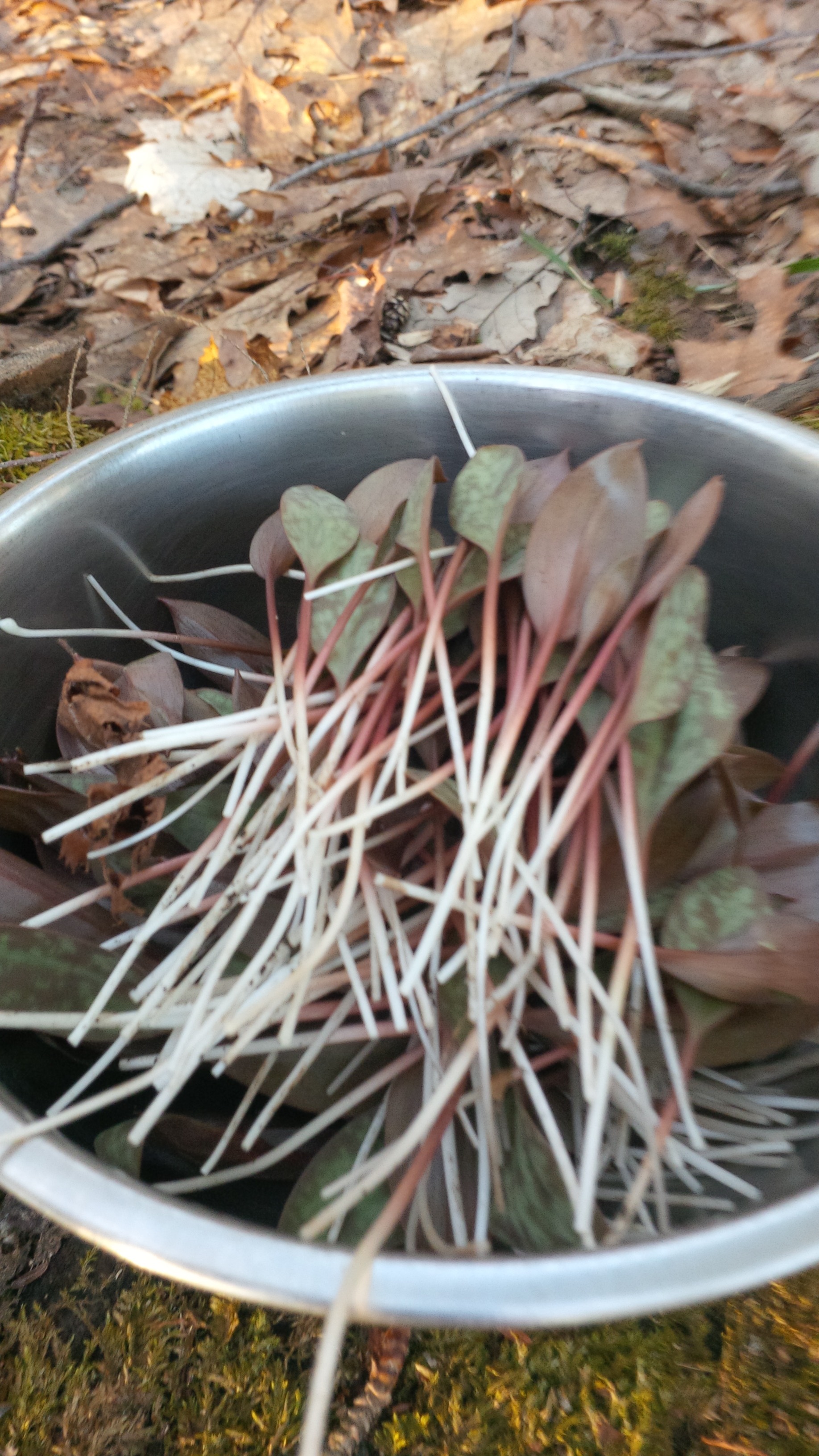
Day lily sprouts
We have a field of these on our property, so we always pick a few to cook up as a spring vegetable – kind of like a leek but a shorter cooking time and milder taste. We’re not sure if we’ll bring some to market or not because the problem is, it seems to inspire people to go picking any other lilies in the city, eating them raw and stomach aches bring inspectors our way even if we have nothing to do with it.
Coltsfoot/Tusselage
This is for my apothecary more than my kitchen, being a pulmonary tonic and good for a cough/sore throat. I use it in my winter cold remedies, tisane and cough syrup. It is the first bloom before dandelion. The spring beauty is starting, nettles are at the baby stage.
It will be the first week end for our spring mesclun at the market, starting with dandelion greens, trout lily and spring beauty, evolving into a more colourful and complex medley, less bitter and sweet as the season evolves.
Although every season feels new, if I look back, I can’t help but think I sound like a broken record, getting excited about the same wild edibles and describing them over and over again eachyear.. So I will keep it short and sweet, but if you’re just tuning in now and want more detail about these spring edibles, here are but a few links to previous posts:
Spring plants from 2012 http://soupnancy.squarespace.com/blog-journalessays/2012/4/14/spring-is-springing.html
Spring plants from 2011 http://soupnancy.squarespace.com/blog-journalessays/2011/5/5/spring-has-finally-sprung.html
And yUpload Filees, its that time of year again - to calm everyone down and reiterate About Fiddleheads.. Dangerous or not, How to cook http://soupnancy.squarespace.com/blog-journalessays/2012/5/14/fiddleheads-for-once-and-for-all.html
When the season peaks, I will make a video - maybe that will get the message across.
Our spring menu at La Table des Jardins Sauvages starts this weekend and the first workshop dinner is on Sunday the 28th at 4pm.









